Wow! It's a return to the grand old movie musicals of the 1940s and 1950s with the fabulous staging and choreography of Susan Stroman and the hilarious dialogue of Mel Brooks in the new movie release of The Producers.
My actor friend Eric and I caught the matinee screening yesterday and it was a wonderful, light-hearted experience. We laughed, we smiled, we wanted to applaud at the end of some of the big production numbers, and after the conclusion I wanted to spin and dance my way out of the theater.
The movie screenplay is pretty faithful to the musical script, and I think they did a better job of translating the musical to the screen than producers for the recent movies of Rent and The Phantom of the Opera. The potentially offensive Negro jokes have been excised with no loss, and it seemed like they cut out a song or two (I'm not one of those people who's memorized the musical soundtrack), but the movie does not suffer.
Casting was good, too. Of course, the Lane-Broderick duo was carried forward. Those of you who are Nathan Lane fans will be happy to know that Nathan is still Nathan. He's a funny, physical actor, but I always think he's Nathan Lane playing Nathan Lane, regardless of the play, musical, tv show, or movie he's doing. And Matthew Broderick—OMG, Ferris Bueller has gotten old and wrinkled!—was a treat with his way-better-than-expected dancing skills. Neither Lane nor Broderick are singers, but they both get through the songs without it being too painful.
A lot of people who've already seen the movie complained about Uma Thurman as Ulla, but I thought she did a fine job in the role. Naturally she's not the woman who did the part in the musical's cast recording, but she does her own interpretation and it was appropriate and entertaining. Will Ferrell surprised me with his performance as Franz Liebkind, and I think this is the first time I've ever liked Ferrell in a movie role. And I can't say enough about John Barrowman, the tenor stormtrooper who fabulously sings "Springtime for Hitler" while looking the epitome of the Aryan youth.
The dance numbers were great, and they did several of those formations with the camera directly overhead like used to be in the old movie musicals. I kept finding myself in wonderment with a stupid grin on my face during most of the big songs, and they made an interesting choice to have big musical endings with a moment of silence (just like they would have done on stage), instead of transitioning immediately back into the dialogue and story, so it felt funny not being able to applaud at the end—it was set up for applause!
Eric thought he recognized someone in the cast with whom he'd been on stage before, so we stayed to watch all the credits (yeah, it turned out it was Eric's former colleague), and we were two of the only five people in the theater to see the little ending vignette with Mel Brooks which played at the very very end of the credits.
So, go see the movie! It's great entertainment.
Friday, December 30, 2005
Thursday, December 29, 2005
I read the book
This evening, I finally read the short story "Brokeback Mountain" from Close Range: Wyoming Stories, by Annie Proulx, which was the basis for the current film Brokeback Mountain playing now in select cities and going into wide release on January 6.
NOTICE: Contains "spoilers."
The short story had been published in New Yorker magazine back in 1997 or 1998, and until recently was available for downloading from the magazine's website. A new book with just "Brokeback Mountain" was published last month as a tie-in to the release of the movie, though, so the New Yorker link has been deactivated. Not wanting to pay the $14.95 for the hardcover or $9.95 for the paperback, I ventured out to a Border's Books, found the special edition (it's thin!), and stood there and read the story. That should tell you just how short this short story is.
The first thing that struck me about the book is how closely the screenplay writers stuck to the original story, even with much of the original dialogue intact. The movie version was able to fill out a lot of the detail in the story, particularly with the mountain vistas, sheep herding, and the family lives of both Ennis and Jack. The one thing they didn't follow was the detailed descriptions of Ennis and Jack written by Proulx. Ennis is supposed to be very skinny with a growth on his eyelid and Jack is supposed to be curly headed and bucktoothed, later getting his teeth fixed and getting fat. I suppose, however, giving us Heath Ledger and Jake Gyllenhaal is a suitably acceptable compromise.
One key scene which is clarified in the short story is Ennis's phone call to Jack's widow, when she tell him about the truck tire accident. The possibility that Jack may have met with tire-iron wielding gay bashers is a flash in Ennis's imagination. When Ennis discovers that Jack may have had an affair with another Texas rancher, he feels the tire iron incident may have been more likely, but there is no confirmation one way or the other.
The other day I mentioned in my movie review that there was one scene other than Jack's death which made all the gay men in the theater gasp and hold their breath. I'll say now that the scene in question is when Ennis is in Jack's bedroom at his parents' house and he discovers Jack's still unwashed bloody shirt from that final fistfight they'd had at the end of their sheep herding summer twenty years previously. Inside Jack's shirt was Ennis's shirt; Jack had wanted them to be together and close just like the shirts; he symbolically put Ennis inside his own skin; it was such a testament to Jack's deep love for Ennis. I think most gay men who've ever been deeply in love still have some relic, some souvenir, of that relationship, however tragically or badly that love affair ended, and thus, the gay audience members were struck both with the emotion of Ennis's discovery and their own emotions recalling from their own life that souvenir of love lost, giving them an Aristotelean catharsis.
The short story is good. This is one of the few times, though, that I'm going to say that I like the screen play better than the book.
NOTICE: Contains "spoilers."
The short story had been published in New Yorker magazine back in 1997 or 1998, and until recently was available for downloading from the magazine's website. A new book with just "Brokeback Mountain" was published last month as a tie-in to the release of the movie, though, so the New Yorker link has been deactivated. Not wanting to pay the $14.95 for the hardcover or $9.95 for the paperback, I ventured out to a Border's Books, found the special edition (it's thin!), and stood there and read the story. That should tell you just how short this short story is.
The first thing that struck me about the book is how closely the screenplay writers stuck to the original story, even with much of the original dialogue intact. The movie version was able to fill out a lot of the detail in the story, particularly with the mountain vistas, sheep herding, and the family lives of both Ennis and Jack. The one thing they didn't follow was the detailed descriptions of Ennis and Jack written by Proulx. Ennis is supposed to be very skinny with a growth on his eyelid and Jack is supposed to be curly headed and bucktoothed, later getting his teeth fixed and getting fat. I suppose, however, giving us Heath Ledger and Jake Gyllenhaal is a suitably acceptable compromise.
One key scene which is clarified in the short story is Ennis's phone call to Jack's widow, when she tell him about the truck tire accident. The possibility that Jack may have met with tire-iron wielding gay bashers is a flash in Ennis's imagination. When Ennis discovers that Jack may have had an affair with another Texas rancher, he feels the tire iron incident may have been more likely, but there is no confirmation one way or the other.
The other day I mentioned in my movie review that there was one scene other than Jack's death which made all the gay men in the theater gasp and hold their breath. I'll say now that the scene in question is when Ennis is in Jack's bedroom at his parents' house and he discovers Jack's still unwashed bloody shirt from that final fistfight they'd had at the end of their sheep herding summer twenty years previously. Inside Jack's shirt was Ennis's shirt; Jack had wanted them to be together and close just like the shirts; he symbolically put Ennis inside his own skin; it was such a testament to Jack's deep love for Ennis. I think most gay men who've ever been deeply in love still have some relic, some souvenir, of that relationship, however tragically or badly that love affair ended, and thus, the gay audience members were struck both with the emotion of Ennis's discovery and their own emotions recalling from their own life that souvenir of love lost, giving them an Aristotelean catharsis.
The short story is good. This is one of the few times, though, that I'm going to say that I like the screen play better than the book.
Monday, December 26, 2005
It's full of allegory, but did they realize......
All month we've been hearing about the Christian allegory in The Chronicles of Narnia: The Lion, the Witch, and the Wardrobe, the new movie based on the children's novel by Christian apologist C.S. Lewis, how many of the evangelical churches have been encouraging their members to see the show, and how evangelical spokesmen have been whining about the attention Hollywood has been paying to Brokeback Mountain whilst ignoring Narnia. Finally, we decided to go see the movie today to form our own opinions and see what all the fuss is about.
Note to parents: This is not an appropriate movie for young children! It is very scary in some spots, one child character is kidnapped and put in bondage, a child is physically struck by the evil character as a means of punishment, there is a prolonged, graphic battle scene, and there are several graphic killings. I would not take any child under eight and I would urge you to use your discretion to consider how sensitive your eight- to ten-year-old child may be.
Narnia is in wide-release, with many theaters showing the film on multiple screens; our auditorium was barely one-quarter full, and there was a predominantly middle aged and older audience with a handful of young children. It's a shame that the evangelicals have conscripted this movie, because I'm sure a lot of the potential audience for the film will stay away because of the Christian cult associations. As an interesting bit of trivia for the evangelicals, the actor portraying Edmond, Skandar Keynes, is the great-great-great-grandson of Charles Darwin.
If you go see Narnia just for its entertainment value, it's not really that bad of a movie. There is a lot of fantasy and battle, and the special effects are generally very good. None of the actors in the cast are known stars, yet they all do an adequate job of portraying their characters (the three "known" actors provide only animal voices: Liam Neeson as Aslan, Rupert Everett as the Fox, and Dawn French (The Vicar of Dibley) as Mrs. Beaver). In many instances, the film reminded me of an elaborate video game which might be played by younger teenagers, and a lot of the plot strongly resembles the stories of Lewis's contemporary at Oxford, J.R.R. Tolkien, and Tolkien's The Lord of the Rings trilogy (and the recent motion picture versions). But Oscar worthy? No. It's still a good movie, though.
I've never been a big fan of Lewis, especially since I used to socialize with a lady who did her doctoral dissertation on Lewis and talked about him incessantly. I've never read the book on which this movie is based, so this analysis is based solely on the movie, not the plot details which may have been included in the book. The plot is simple. Four British siblings are sent to live in a country house during the London bombings in World War II. In the new house, they discover a wardrobe (or what we might call an "armoire," a big piece of furniture for storing clothing) in an upstairs bedroom which some how magically leads to the mystical and magic land of Narnia, which is populated with all sorts of mythological creatures and talking animals. All is not well in Narnia, though, as their benevolent god-leader, the lion Aslan, has been driven out of the land for the past one hundred years by the evil White Witch, Jadis. The arrival of the four human children, however, inspires Aslan's return because of a prophecy that four humans would help defeat the powers of evil and return happiness to the land of Narnia.
The story line sets up the classic battle between good and evil, though I think the allegory here is a little odd for Christians, since the good guys are dependent upon magic and potions to achieve their victory. There is a rather lame Christ-like self-sacrifice by Aslan for the greater good. Otherwise, I found no strong Christian message, and any number of allegorical meanings can be thought up to fit this script. Perhaps things are clearer in the book, but I missed the sermon in the movie.
In this allegorical vacuum, one thing that jumped out at me to my great surprise is the high degree of homoerotic imagery and allegory in this film.
First of all, the eldest of the four children is a tall, slender, blond-haired, blue-eyed, sixteen- or seventeen-year-old boy with a ruddy flush to his cheeks and a soft British accent, the quintessential sexual interest of ephebophilic British academics like Lewis. His name is Peter (at least it's not Lance or Rod or something), and when the four children assume their thrones as kings and queens of Narnia, he is crowned King Peter the Magnificent. He has a long, broad, shiny sword that he likes to pull out and hold a lot and which he received as a gift from an older, bearded man, representing both Santa Claus and a sugar daddy, who taught him how to use it. And further, Peter the Magnificent rides into battle atop a white unicorn; between the unicorn's horn and Peter's sword, there is double phallic imagery and the two phalli, representing the phalli of a homosexual couple, are needed to vanquish (with the help of extra magic from others) the evil female witch. In several scenes, he reminded me of the blond Colin Farrell in the gay movie, Alexander, riding around playing army commander. Late in the movie, we see the children all grown up, with the very adult and bearded Peter having no wife or girlfriend, and just happily hanging out with his sisters; clearly Peter has chosen a homosexual lifestyle and is very content and successful with it.
Peter's younger brother, Edmond, is about twelve to fourteen years old and has dark brown hair and the most gorgeous big brown eyes. Edmond is constantly admonished to follow The Way of his elder brother, but he rebels and aligns himself with the evil female. The evil witch just uses Edmond for what he can give her, giving him a little "Turkish delight" as a reward for his good behaviors, then puts him in chains in a dungeon after she has slapped the crap out of his face, meaning that those boys who go after women will fall into the evil ways of BDSM culture and become beaten-bloody submissives. Two supporting characters attempt to help Edmond return to The Way of his brother; he betrays them both, though, trying to gain the affections and approval of the evil female, and in both cases the evil female turns the good guy into stone. When Edmond finally turns away from the evil female to join The Way of his brother, she gets her revenge by running him through with a spear, teaching us of the treachery of women and the superior homosexual path of The Way.
Jadis the White Witch has really bad hair, reminding us of the social unsuitability of anyone with bad hair. She wears a lot of big dresses which would be the envy of any drag queen, and she is surrounded by attendants who are bears and trolls. And, once the evil White Witch is vanquished, all of her minions and bad guys disappear, giving us another message about her kind of culture, how worshipping a witch/female as a queen is wrong, and the goodness and superiority of The Way.
The two sisters represent two present-but-unneeded female archtypes in homosexual culture. Big sister Susan has become "boring" according to her siblings and is an unadventurous nag, just like the age-appropriate, marriage-seeking females who would want to date a boy like Peter. Little sister Lucy is a chubby, fun-loving girl who encourages her brothers to do things and go places, always wanting to tag along, representing the archtypal "fag hag."
Far-fetched? Unintentional? Gay propaganda? Consider these things:
So, rather than being a great Christian movie, I'm afraid we're going to have to explain to all the evangelicals that this movie is merely another Hollywood glorification of homosexuality and the Gay Agenda.
Note to parents: This is not an appropriate movie for young children! It is very scary in some spots, one child character is kidnapped and put in bondage, a child is physically struck by the evil character as a means of punishment, there is a prolonged, graphic battle scene, and there are several graphic killings. I would not take any child under eight and I would urge you to use your discretion to consider how sensitive your eight- to ten-year-old child may be.
Narnia is in wide-release, with many theaters showing the film on multiple screens; our auditorium was barely one-quarter full, and there was a predominantly middle aged and older audience with a handful of young children. It's a shame that the evangelicals have conscripted this movie, because I'm sure a lot of the potential audience for the film will stay away because of the Christian cult associations. As an interesting bit of trivia for the evangelicals, the actor portraying Edmond, Skandar Keynes, is the great-great-great-grandson of Charles Darwin.
If you go see Narnia just for its entertainment value, it's not really that bad of a movie. There is a lot of fantasy and battle, and the special effects are generally very good. None of the actors in the cast are known stars, yet they all do an adequate job of portraying their characters (the three "known" actors provide only animal voices: Liam Neeson as Aslan, Rupert Everett as the Fox, and Dawn French (The Vicar of Dibley) as Mrs. Beaver). In many instances, the film reminded me of an elaborate video game which might be played by younger teenagers, and a lot of the plot strongly resembles the stories of Lewis's contemporary at Oxford, J.R.R. Tolkien, and Tolkien's The Lord of the Rings trilogy (and the recent motion picture versions). But Oscar worthy? No. It's still a good movie, though.
I've never been a big fan of Lewis, especially since I used to socialize with a lady who did her doctoral dissertation on Lewis and talked about him incessantly. I've never read the book on which this movie is based, so this analysis is based solely on the movie, not the plot details which may have been included in the book. The plot is simple. Four British siblings are sent to live in a country house during the London bombings in World War II. In the new house, they discover a wardrobe (or what we might call an "armoire," a big piece of furniture for storing clothing) in an upstairs bedroom which some how magically leads to the mystical and magic land of Narnia, which is populated with all sorts of mythological creatures and talking animals. All is not well in Narnia, though, as their benevolent god-leader, the lion Aslan, has been driven out of the land for the past one hundred years by the evil White Witch, Jadis. The arrival of the four human children, however, inspires Aslan's return because of a prophecy that four humans would help defeat the powers of evil and return happiness to the land of Narnia.
The story line sets up the classic battle between good and evil, though I think the allegory here is a little odd for Christians, since the good guys are dependent upon magic and potions to achieve their victory. There is a rather lame Christ-like self-sacrifice by Aslan for the greater good. Otherwise, I found no strong Christian message, and any number of allegorical meanings can be thought up to fit this script. Perhaps things are clearer in the book, but I missed the sermon in the movie.
In this allegorical vacuum, one thing that jumped out at me to my great surprise is the high degree of homoerotic imagery and allegory in this film.
First of all, the eldest of the four children is a tall, slender, blond-haired, blue-eyed, sixteen- or seventeen-year-old boy with a ruddy flush to his cheeks and a soft British accent, the quintessential sexual interest of ephebophilic British academics like Lewis. His name is Peter (at least it's not Lance or Rod or something), and when the four children assume their thrones as kings and queens of Narnia, he is crowned King Peter the Magnificent. He has a long, broad, shiny sword that he likes to pull out and hold a lot and which he received as a gift from an older, bearded man, representing both Santa Claus and a sugar daddy, who taught him how to use it. And further, Peter the Magnificent rides into battle atop a white unicorn; between the unicorn's horn and Peter's sword, there is double phallic imagery and the two phalli, representing the phalli of a homosexual couple, are needed to vanquish (with the help of extra magic from others) the evil female witch. In several scenes, he reminded me of the blond Colin Farrell in the gay movie, Alexander, riding around playing army commander. Late in the movie, we see the children all grown up, with the very adult and bearded Peter having no wife or girlfriend, and just happily hanging out with his sisters; clearly Peter has chosen a homosexual lifestyle and is very content and successful with it.
Peter's younger brother, Edmond, is about twelve to fourteen years old and has dark brown hair and the most gorgeous big brown eyes. Edmond is constantly admonished to follow The Way of his elder brother, but he rebels and aligns himself with the evil female. The evil witch just uses Edmond for what he can give her, giving him a little "Turkish delight" as a reward for his good behaviors, then puts him in chains in a dungeon after she has slapped the crap out of his face, meaning that those boys who go after women will fall into the evil ways of BDSM culture and become beaten-bloody submissives. Two supporting characters attempt to help Edmond return to The Way of his brother; he betrays them both, though, trying to gain the affections and approval of the evil female, and in both cases the evil female turns the good guy into stone. When Edmond finally turns away from the evil female to join The Way of his brother, she gets her revenge by running him through with a spear, teaching us of the treachery of women and the superior homosexual path of The Way.
Jadis the White Witch has really bad hair, reminding us of the social unsuitability of anyone with bad hair. She wears a lot of big dresses which would be the envy of any drag queen, and she is surrounded by attendants who are bears and trolls. And, once the evil White Witch is vanquished, all of her minions and bad guys disappear, giving us another message about her kind of culture, how worshipping a witch/female as a queen is wrong, and the goodness and superiority of The Way.
The two sisters represent two present-but-unneeded female archtypes in homosexual culture. Big sister Susan has become "boring" according to her siblings and is an unadventurous nag, just like the age-appropriate, marriage-seeking females who would want to date a boy like Peter. Little sister Lucy is a chubby, fun-loving girl who encourages her brothers to do things and go places, always wanting to tag along, representing the archtypal "fag hag."
Far-fetched? Unintentional? Gay propaganda? Consider these things:
—Lewis was a lifelong academic at Oxford, and later Cambridge, during an era when discreet homosexuality and pederasty was common amongst the upper classes, especially in prep school and collegiate academic settings.While there is no proof of Lewis being a homosexual or committing homosexual acts, there is ample circumstantial evidence which points out the strong possibility of a potential homosexual psychological orientation, especially when viewed as a whole. I submit, therefore, that veiled homosexual messages are just as probable in Narnia as the more openly-discussed Christian messages, and that while Lewis may have intended an overt Christian message, he also may have included a major subtext glorifying pederasty and homosexuality.
—Lewis formed a close friendship with a fellow soldier in World War I who was later killed in combat.
—Lewis invited his Army friend's mother to live with him and supported her until her death in 1951.
—Lewis was estranged from his father.
—Lewis had bouts of depression.
—Lewis went to an English public school (what we Americans would call a private boarding school or prep school) where he was extremely unathletic.
—Lewis did not marry until 1956 when he was 57 years old, wedding a divorced Jewish poetess said to be his intellectual equal who fascinated him on an professional level.
—He admitted to having married solely so that his wife could stay in England and not have to return to her country.
—His wife soon became mortally ill with bone cancer, and it would be reasonable to assume that they would have had a limited sex life because of her illness.
—Several Lewis biographers report that while Lewis and his wife loved one another very much, the relationship was platonic.
—After his wife's 1960 death, he did not remarry and lived with his elder brother until his death.
—As a child, Lewis loved Beatrice Potter stories because they featured "dressed animals," and wrote and illustrated his own animal stories.
—Anglican Christians in the early 20th century did not manifest the great hatred of homosexuals currently seen amongst American evangelical Christians.
So, rather than being a great Christian movie, I'm afraid we're going to have to explain to all the evangelicals that this movie is merely another Hollywood glorification of homosexuality and the Gay Agenda.
Sunday, December 18, 2005
Nutcracker blues
Well, the idiots in management and on the board at Washington Ballet, who locked out the dancers last week over a safe working conditions dispute, basically thumbed their noses at the dancers and their patrons, and canceled the rest of their Nutcracker run. This is not the first time the company has had labor problems over board policies, working conditions, and relationships with artistic director Septime Weber. The Nutcracker is the major money maker for most ballet companies in the country, a money maker that allows them to do their other works during the course of the year. Washington Ballet's run only lasted half the scheduled time, and they will have cancellation costs for the Warner Theater and the contracted orchestra musicians for the final two weeks, so that will eat up any profit they might have had from the first half of the run. Sadly, it also puts the remainder of the season in peril and it bodes poorly for the continuing viability of this ballet company in future seasons.
Heavy handed anti-union techniques may be appropriate for industrial-type labor, but it is incredibly shortsighted and inappropriate in the non-profit arts arena. I have been saddened at all of the labor disputes I've personally witnessed around the country during the past decade or so where the boards (who are supposed to be trustees for the public interest) have shut down orchestras and dance companies, rather than working with the artists to resolve concerns, impoverishing all of us and killing the fine arts in the parts of the country which need them most. Arts organization board members need to start doing their jobs and stop treating their groups as social occasions and opportunities for cocktail parties.
Classical musicians and dancers are highly educated professionals, many with graduate degrees, who deserve a living wage and safe working conditions. Having company management tell the press when dancers complain about a sharp increase in injuries during a rehearsal period that injury rates are "consistent with average injury rates at other companies" is not the sort of thing you want known by people like me who've been plaintiffs' personal injury attorneys! And it certainly isn't good public relations to show patrons how little management respects dancers.
So, having passed up an opportunity to see Nutcracker danced earlier this month at the Kennedy Center by the better American Ballet Theater from New York City, I'm a bit miffed at Washington Ballet's board and management. I was wanting my limited entertainment dollars to support a local group instead of a well-funded national company, and I was also curious to see Washington Ballet's "Washingtonized" production, re-imagined and set in Georgetown. Alas, the company will probably fold now, and I'll never get to see it.
I'm not going without my annual Nutcracker fix, however, as we went this afternoon to the closing performance of the Bartlesville Civic Ballet in Marie Foster Hall at the Taliesin West/Frank Lloyd Wright Foundation-designed Bartlesville Community Center (in the shadow of the Price Tower, Wright's only skyscraper). It's a bit of a nostalgic journey for me, since this is the company where I made my dance debut decades ago in Graduation Ball, and balletmistress "Miss Charlotte" is still imperiously presiding over the company!
There is a certain charm to watching a civic ballet. Since we're looking at kids and students instead of professionals, we can appreciate a performance for its sweetness and for unexpected gems, rather than watching with a hypercritical eye for perfect dance technique and brilliantly innovative choreography. Bartlesville has always had a good company, and they draw dancers from other nearby small cities. Miss Charlotte also invites back a few of her former dancers once they've gone off to college, and had a half dozen young women and one very handsome young man (and, wow, has he grown up since I last saw him dance!) to serve as soloists for this production; the better high school-aged dancers are demi-soloists.
The prima ballerina and premier danseur for this production were guest artists Mary Elizabeth Arrington from City Ballet of Houston (formerly of Tulsa Ballet) and Domingo Rubio formerly of Ballet Hispanico of New York, Joffrey-Chicago, and the National Dance Company of Mexico, dancing the snow queen and king, the sugar plum fairy, and the cavalier.
As usual, the kindergartener-aged kids as baby mice and as angels stole the show. Never discount the "ah" factor! I was holding my breath during the dance of the snowflakes because the tech people had fake snow falling in pooled "blizzards" on the stage, right where some of the women were not only dancing en pointe, but were doing pirouhettes and leaps, and I just knew someone was going to fall and break a leg! All was well, though, and it was a very successful afternoon, even with all the sleepy and tired pre-schoolers in the audience who did just fine for act one, but got cranky before the end of act two.
Of course, the highlight for me for the afternoon was seeing all the cute young daddies in the audience sitting with their children. Some of them were so cute (and I don't mean the kids)!
I probably should have stuck around for the post-performance reception to say hi to Miss Charlotte, but we decided to escape while we could to avoid the traffic (traffic being a relative term in Bartlesville) since we somehow managed to be amongst the first out of the auditorium. Just as well. I'm not feeling social today.
Heavy handed anti-union techniques may be appropriate for industrial-type labor, but it is incredibly shortsighted and inappropriate in the non-profit arts arena. I have been saddened at all of the labor disputes I've personally witnessed around the country during the past decade or so where the boards (who are supposed to be trustees for the public interest) have shut down orchestras and dance companies, rather than working with the artists to resolve concerns, impoverishing all of us and killing the fine arts in the parts of the country which need them most. Arts organization board members need to start doing their jobs and stop treating their groups as social occasions and opportunities for cocktail parties.
Classical musicians and dancers are highly educated professionals, many with graduate degrees, who deserve a living wage and safe working conditions. Having company management tell the press when dancers complain about a sharp increase in injuries during a rehearsal period that injury rates are "consistent with average injury rates at other companies" is not the sort of thing you want known by people like me who've been plaintiffs' personal injury attorneys! And it certainly isn't good public relations to show patrons how little management respects dancers.
So, having passed up an opportunity to see Nutcracker danced earlier this month at the Kennedy Center by the better American Ballet Theater from New York City, I'm a bit miffed at Washington Ballet's board and management. I was wanting my limited entertainment dollars to support a local group instead of a well-funded national company, and I was also curious to see Washington Ballet's "Washingtonized" production, re-imagined and set in Georgetown. Alas, the company will probably fold now, and I'll never get to see it.
I'm not going without my annual Nutcracker fix, however, as we went this afternoon to the closing performance of the Bartlesville Civic Ballet in Marie Foster Hall at the Taliesin West/Frank Lloyd Wright Foundation-designed Bartlesville Community Center (in the shadow of the Price Tower, Wright's only skyscraper). It's a bit of a nostalgic journey for me, since this is the company where I made my dance debut decades ago in Graduation Ball, and balletmistress "Miss Charlotte" is still imperiously presiding over the company!
There is a certain charm to watching a civic ballet. Since we're looking at kids and students instead of professionals, we can appreciate a performance for its sweetness and for unexpected gems, rather than watching with a hypercritical eye for perfect dance technique and brilliantly innovative choreography. Bartlesville has always had a good company, and they draw dancers from other nearby small cities. Miss Charlotte also invites back a few of her former dancers once they've gone off to college, and had a half dozen young women and one very handsome young man (and, wow, has he grown up since I last saw him dance!) to serve as soloists for this production; the better high school-aged dancers are demi-soloists.
The prima ballerina and premier danseur for this production were guest artists Mary Elizabeth Arrington from City Ballet of Houston (formerly of Tulsa Ballet) and Domingo Rubio formerly of Ballet Hispanico of New York, Joffrey-Chicago, and the National Dance Company of Mexico, dancing the snow queen and king, the sugar plum fairy, and the cavalier.
As usual, the kindergartener-aged kids as baby mice and as angels stole the show. Never discount the "ah" factor! I was holding my breath during the dance of the snowflakes because the tech people had fake snow falling in pooled "blizzards" on the stage, right where some of the women were not only dancing en pointe, but were doing pirouhettes and leaps, and I just knew someone was going to fall and break a leg! All was well, though, and it was a very successful afternoon, even with all the sleepy and tired pre-schoolers in the audience who did just fine for act one, but got cranky before the end of act two.
Of course, the highlight for me for the afternoon was seeing all the cute young daddies in the audience sitting with their children. Some of them were so cute (and I don't mean the kids)!
I probably should have stuck around for the post-performance reception to say hi to Miss Charlotte, but we decided to escape while we could to avoid the traffic (traffic being a relative term in Bartlesville) since we somehow managed to be amongst the first out of the auditorium. Just as well. I'm not feeling social today.
Friday, December 16, 2005
Celebrating the solstice
Tonight I went to the Christmas Revels in Lisner Auditorium on the George Washington University campus. The Revels this year is called "Journey to the Northlands" (the cultures rotate annually) and is a celebration of Yuletide in the Scandanavian countries with traditions and customs dating back to pre-Christian Druidism and sun worship surrounding the winter solstice. A surprising number of our Christmas customs, including Yule logs, egg nog, evergreens in the house, candles, and decorating trees, come from pagan traditions of Druidism and northwestern European mythology.
It was a long show, running from 7:30 until 10:15, and the mixture of song, dance, and theatrics helped the time fly, even in view of the extremely uncomfortable seating in Lisner Auditorium. I was also kind of annoyed by their management policy to seat latecomers, with some people coming in as much as forty minutes after curtain time, and then they had the ushers show the truants to their actual seats, which, if in the middle of a section, necessitated whole lines of people standing up to allow passage through the extremely narrow rows, all the while obscuring the view and other distracting the people behind. The auditorium also seems to be lacking in adequate restroom facilities: restrooms were in the basement under the lobby, and the mens' room had only three toilet stalls and three urinals, and I would predict the women's room was of similar size, given the locations, which is just not enough to handle a crowd of 1500.
It was interesting listening to some of the creation stories from Iceland, Sweden, Denmark, Norway, and Finland and hearing others of the many traditional mythological tales from the area, many of which were told with heroic sized puppets. While there was a little bit of overt "Christmas content" in the show, most of it was more folk-traditional, so we saw not only mythology but a lot of the solstice traditions. They imported some excellent acrobatic dancers and several traditional folk musicians from Europe to round out the cast of over a hundred people. Several times they had cast members dancing in the aisles out in the house, and they were big on audience participation, asking them to waive their arms, clap their hands, or sing traditional songs.
It was a fun show. I wish my Finnish friend Henri had been here—he could have told me what was going on! If anyone is in D.C. this weekend, they are doing two shows tomorrow and one Sunday.
It was a long show, running from 7:30 until 10:15, and the mixture of song, dance, and theatrics helped the time fly, even in view of the extremely uncomfortable seating in Lisner Auditorium. I was also kind of annoyed by their management policy to seat latecomers, with some people coming in as much as forty minutes after curtain time, and then they had the ushers show the truants to their actual seats, which, if in the middle of a section, necessitated whole lines of people standing up to allow passage through the extremely narrow rows, all the while obscuring the view and other distracting the people behind. The auditorium also seems to be lacking in adequate restroom facilities: restrooms were in the basement under the lobby, and the mens' room had only three toilet stalls and three urinals, and I would predict the women's room was of similar size, given the locations, which is just not enough to handle a crowd of 1500.
It was interesting listening to some of the creation stories from Iceland, Sweden, Denmark, Norway, and Finland and hearing others of the many traditional mythological tales from the area, many of which were told with heroic sized puppets. While there was a little bit of overt "Christmas content" in the show, most of it was more folk-traditional, so we saw not only mythology but a lot of the solstice traditions. They imported some excellent acrobatic dancers and several traditional folk musicians from Europe to round out the cast of over a hundred people. Several times they had cast members dancing in the aisles out in the house, and they were big on audience participation, asking them to waive their arms, clap their hands, or sing traditional songs.
It was a fun show. I wish my Finnish friend Henri had been here—he could have told me what was going on! If anyone is in D.C. this weekend, they are doing two shows tomorrow and one Sunday.
Review: Brokeback Mountain
Stunning vistas, beautiful horses, and an Oscar-worthy performance by Heath Ledger have brought the mountain to the people.
Braving huge lines of people extending out the theater doors, down the street all the way to the Metro station and beyond, and I, wearing my black Stetson, caught the opening Washington, D.C., performance of Brokeback Mountain today at 1 p.m. Those without online ticket reservations were being shunted to the 2 p.m. showing, as the 1 p.m. show sold out online. It was an eccelectic crowd, largely male, but a not exclusively so, and with a broad range of ages from the geriatric to the teenaged. The movie is still in limited release across the country, so the one and only D.C. theater showing the film was the Loew's Dupont Circle 5, an older, smaller place usually limited to showing art and independent films, where they devoted three of their five screens to Brokeback Mountain with hourly showings.
We've all heard the storyline over the past several weeks prior to the opening about how two cowboys, Ennis (Heath Ledger) and Jack (Jake Gyllenhaal) meet, fall in love, marry women, live in different states, and continue their romance for twenty years until the death of one of them. Director Ang Lee has created a beautiful epic period piece, helped in no small measure by the gorgeous Wyoming mountain landscapes. Those of us from the heartland will recognize every character from our rural experiences, and we know people just like each of the actors.
The Australian Ledger was noteworthy in his part as the quiet country man who doesn't talk much, and when he does, he speaks in a near monotone, only opening his mouth wide enough for a cigarette or maybe the occasional beer bottle. There was no trace of Ledger's natural Aussie accent as he convincing portrayed the flat, Wyoming western-American accent. As with so many of the men we know just like this, the only emotion he is confortable expressing is anger; nevertheless, between Ledger's expressive eyes and the tensing of muscles in his face, plus Lee's skillful direction, we can feel the depth and strength of his other emotions. Ledger has already been nominated for best actor with the Golden Globes, and he should also be nominated when it comes time for the Academy Awards.
Ennis lives in Riverton, Wyoming, where several of my cousins live! I daresay I've never seen that "post office" building before, even back in the 1960s and 1970s.
Gyllenhaal also offers a strong performance, but this is another situation like with the movie Amadeus, where both Tom Hulce (Mozart) and F. Murray Abraham (Salieri) were nominated for the best actor Oscar ultimately won by Abraham.
Many people in areas of the country where Brokeback Mountain has not yet been released have been asking me about whether or not this movie is suitable for seeing with family. I would say that it would be alright to see with parents and adult siblings or relatives, but I would be reluctant to take anyone under 16. Nudity in the film is limited; there is one scene where the cowboys strip off all their clothes so they can jump off a cliff to swim in the lake below, but the camera films the scene in a long shot, so while the viewer knows the cowboys are naked, one can't see anything; in another scene one of the cowboys has sex with his wife, and when he rolls off of her, there is a substantial nude breast shot; each cowboy also has a solo nude bathing scene, but they are both filmed in profile in a non-prurient, non-revealing way.
The one brief scene which makes me question the propriety of the movie for young teens is when the cowboys first make love. It's an unexpected, spontaneous moment when they roughly rip one another clothes off and have to use spit for lubricant; while we don't see much more than faces, we know exactly what is happening. While heterosexual movie equivalents to this scene are often longer and more graphic, society as a whole is still not used to the idea of homosexual lovemaking let alone watching it on screen. Consequently, I will not be surprised in the least if some small town, red state courthouse doesn't play host to an obsenity lawsuit if this movie plays in that county (the fact that it is clearly not obscene does not bar litigation for a formal determination of that fact, especially since 2006 is an election year).
The pace of the movie is stately, and there are no real action scenes to wake up the Great Unwashed Masses. Similarly, while it's a love story showing the unexplored area of two non-flamboyent men, it is not maudlin or melodramatic. And, interestingly, the one tearful time in the movie was not the death of one of the cowboys, but something afterwards (which I will not reveal here—after you've seen the movie, email me and we'll talk), when I heard most every gay man in the theater gasp and hold his breath. Go see it—you'll know what I'm talking about it when you see it.
So, Brokeback Mountain is excellent, and it doesn't disappoint. I urge you to go see it as soon as you can when it opens in your area.
Braving huge lines of people extending out the theater doors, down the street all the way to the Metro station and beyond, and I, wearing my black Stetson, caught the opening Washington, D.C., performance of Brokeback Mountain today at 1 p.m. Those without online ticket reservations were being shunted to the 2 p.m. showing, as the 1 p.m. show sold out online. It was an eccelectic crowd, largely male, but a not exclusively so, and with a broad range of ages from the geriatric to the teenaged. The movie is still in limited release across the country, so the one and only D.C. theater showing the film was the Loew's Dupont Circle 5, an older, smaller place usually limited to showing art and independent films, where they devoted three of their five screens to Brokeback Mountain with hourly showings.
We've all heard the storyline over the past several weeks prior to the opening about how two cowboys, Ennis (Heath Ledger) and Jack (Jake Gyllenhaal) meet, fall in love, marry women, live in different states, and continue their romance for twenty years until the death of one of them. Director Ang Lee has created a beautiful epic period piece, helped in no small measure by the gorgeous Wyoming mountain landscapes. Those of us from the heartland will recognize every character from our rural experiences, and we know people just like each of the actors.
The Australian Ledger was noteworthy in his part as the quiet country man who doesn't talk much, and when he does, he speaks in a near monotone, only opening his mouth wide enough for a cigarette or maybe the occasional beer bottle. There was no trace of Ledger's natural Aussie accent as he convincing portrayed the flat, Wyoming western-American accent. As with so many of the men we know just like this, the only emotion he is confortable expressing is anger; nevertheless, between Ledger's expressive eyes and the tensing of muscles in his face, plus Lee's skillful direction, we can feel the depth and strength of his other emotions. Ledger has already been nominated for best actor with the Golden Globes, and he should also be nominated when it comes time for the Academy Awards.
Ennis lives in Riverton, Wyoming, where several of my cousins live! I daresay I've never seen that "post office" building before, even back in the 1960s and 1970s.
Gyllenhaal also offers a strong performance, but this is another situation like with the movie Amadeus, where both Tom Hulce (Mozart) and F. Murray Abraham (Salieri) were nominated for the best actor Oscar ultimately won by Abraham.
Many people in areas of the country where Brokeback Mountain has not yet been released have been asking me about whether or not this movie is suitable for seeing with family. I would say that it would be alright to see with parents and adult siblings or relatives, but I would be reluctant to take anyone under 16. Nudity in the film is limited; there is one scene where the cowboys strip off all their clothes so they can jump off a cliff to swim in the lake below, but the camera films the scene in a long shot, so while the viewer knows the cowboys are naked, one can't see anything; in another scene one of the cowboys has sex with his wife, and when he rolls off of her, there is a substantial nude breast shot; each cowboy also has a solo nude bathing scene, but they are both filmed in profile in a non-prurient, non-revealing way.
The one brief scene which makes me question the propriety of the movie for young teens is when the cowboys first make love. It's an unexpected, spontaneous moment when they roughly rip one another clothes off and have to use spit for lubricant; while we don't see much more than faces, we know exactly what is happening. While heterosexual movie equivalents to this scene are often longer and more graphic, society as a whole is still not used to the idea of homosexual lovemaking let alone watching it on screen. Consequently, I will not be surprised in the least if some small town, red state courthouse doesn't play host to an obsenity lawsuit if this movie plays in that county (the fact that it is clearly not obscene does not bar litigation for a formal determination of that fact, especially since 2006 is an election year).
The pace of the movie is stately, and there are no real action scenes to wake up the Great Unwashed Masses. Similarly, while it's a love story showing the unexplored area of two non-flamboyent men, it is not maudlin or melodramatic. And, interestingly, the one tearful time in the movie was not the death of one of the cowboys, but something afterwards (which I will not reveal here—after you've seen the movie, email me and we'll talk), when I heard most every gay man in the theater gasp and hold his breath. Go see it—you'll know what I'm talking about it when you see it.
So, Brokeback Mountain is excellent, and it doesn't disappoint. I urge you to go see it as soon as you can when it opens in your area.
Weekend entertainment
What to do? What to do?
Was going to go see Washington Ballet's "Georgetown-updated" version of The Nutcracker tonight, but they are having yet another labor dispute between management and the dancers, and management locked out the dancers and cancelled Thursday night's performance. Sometimes arts organization management can be so stupid. Who knows when the dispute will be over and when Nutcracker will be back on?
Brokeback Mountain opens later today....as far as I can tell, the first showing is at 1 p.m. at that art theater just south of Dupont Circle. Who wants to go with me?
Does anybody celebrate the Winter Solstice? Any pagans out there? There's some kind of "musical and theatrical celebration of the Winter Solstice" at Lisner Auditorium this weekend, and I'm kind of intrigued. Is anyone else?
Was going to go see Washington Ballet's "Georgetown-updated" version of The Nutcracker tonight, but they are having yet another labor dispute between management and the dancers, and management locked out the dancers and cancelled Thursday night's performance. Sometimes arts organization management can be so stupid. Who knows when the dispute will be over and when Nutcracker will be back on?
Brokeback Mountain opens later today....as far as I can tell, the first showing is at 1 p.m. at that art theater just south of Dupont Circle. Who wants to go with me?
Does anybody celebrate the Winter Solstice? Any pagans out there? There's some kind of "musical and theatrical celebration of the Winter Solstice" at Lisner Auditorium this weekend, and I'm kind of intrigued. Is anyone else?
Wednesday, December 14, 2005
Review: Guantanamo
How many people are being incarcerated detained at the U.S. Naval Base at Guantanamo Bay, Cuba?
Ever since the country entered the "War on Terror" in 2001, the American and British governments have been hard pressed to demonstrate that they are doing something to make the world safe for democracy, that they are doing something to insure the safety of citizens. Of course, there are only so many goat herds and tents that one can blow up in Afghanistan and so many weapons of mass destruction not to be found in Iraq, so Coalition forces turned to political and religious leaders who support Enemies of Freedom in Afghanistan, Iraq, and throughout the world. The problem is, how far down does the "problem" go? And who supports Enemies of Freedom: after all, don't all those bearded ragheads look alike?
As American and British politicians have so often reminded the public, there is no formally organized, official government or group which is the enemy in the War on Terror; consequently, it is a challenge to ascertain who in a village or who in a mosque is "good" and who is "bad." The governments' responses have been pretty much just a matter of suspecting any dark skinned Muslim male, although they will deny that. Choosing to "err" on the side of safety, large numbers of Muslims have been rounded up and held by military and police authorities for questioning—questioning which can last for months or years. Calling these people being held "enemy combatants" rather than "prisoners of war," theprisoners detainees have been denied Geneva Convention rights and initially were denied American constitutional rights of habeas corpus and speedy trials. Nearly a thousand people have been detained at Guantanamo Bay without any criminal or military charges against them, and liberal human rights groups estimate that over five hundred are still imprisoned detained today.
With this historical background, British playwrights Victoria Brittain and Gillian Slovo have crafted the documentary play, Guantanamo: 'Honor Bound to Defend Freedom,', which has been playing this past month in the Milton Theater at Washington's Studio Theater. What is particularly interesting about this play is that it isn't just another fictional, whiny, liberal rant; the lines are actual quotations from trial and deposition testimony and politicians' press conferences and speeches.
The truth of the lines is the strength of the play; at the same time, the documentary approach is the play's weakness. It's a hard two hours for the audience.
As the audience enters the theater, it is met with a stark, uncurtained stage. Tall chain link fencing runs all the way across the upstage side of the stage. Spread across the stage on both sides of the fence are sturdy metal cots with thin mattresses, each occupied by a man, some in white underwear, some in orange jumpsuits, all bored, all alone. These men remained on their cots throughout the play, throughout intermission, and were still in place when the audience left the theater at the end of the evening. Down stage of the cots, five sets of a small table and a chair were arranged across the stage in two rows.
As the play opens, the tables and chairs are filled with various, occasionally changing, seated characters: a few parents, a couple of former detainees, a brother, several reporters, a couple of lawyers, and so forth. An actor portraying a British law lord enters from the back of the house, walks to a podium down center stage, and gives a speech to the House of Lords about the "situation." Thus the barrage of quotations and testimony begins. Next, the various characters on stage give their testimony as a series of interwoven solilioquies, sometimes even quoting letters from detained family members, giving a couple of the detainees the opportunity to deliver lines. There is no real interaction between the characters, there is essentially no action to the play, other than quietly walking on stage to take a seat, and the lines are not quickly or melodramatically delivered, though, which is why the audience must be both engaged in the material and very much awake. The script is very much just a slice of life without any real beginning or ending, and no self-righteous concluding preaching. There is no curtain call, and the on-stage detainees merely continue their trying existence.
This is very much an ensemble cast. Several of the actors played multiple parts. While it is difficult to single out specific actors, Leo Erickson gave a chillingly accurate portrayal of U.S. Secretary of Defense Donald Rumsfeld, and many television viewers will recognize "former detainee" Andrew Stewart-Jones from his appearances on Third Watch, Sex & the City, and various commercials.
Guantanamo, which opened November 2, closed this past Sunday, so readers, unfortunately, will no longer be able to view this production. Given the ongoing political climate, the continuing military action, the current Congressional debate about detainee and prisoner torture, and the pressures of Christian and Muslim fundamentalism, this play will no doubt be mounted by other companies elsewhere in the country, and it has a message which deserves to be heard and considered.
Ever since the country entered the "War on Terror" in 2001, the American and British governments have been hard pressed to demonstrate that they are doing something to make the world safe for democracy, that they are doing something to insure the safety of citizens. Of course, there are only so many goat herds and tents that one can blow up in Afghanistan and so many weapons of mass destruction not to be found in Iraq, so Coalition forces turned to political and religious leaders who support Enemies of Freedom in Afghanistan, Iraq, and throughout the world. The problem is, how far down does the "problem" go? And who supports Enemies of Freedom: after all, don't all those bearded ragheads look alike?
As American and British politicians have so often reminded the public, there is no formally organized, official government or group which is the enemy in the War on Terror; consequently, it is a challenge to ascertain who in a village or who in a mosque is "good" and who is "bad." The governments' responses have been pretty much just a matter of suspecting any dark skinned Muslim male, although they will deny that. Choosing to "err" on the side of safety, large numbers of Muslims have been rounded up and held by military and police authorities for questioning—questioning which can last for months or years. Calling these people being held "enemy combatants" rather than "prisoners of war," the
With this historical background, British playwrights Victoria Brittain and Gillian Slovo have crafted the documentary play, Guantanamo: 'Honor Bound to Defend Freedom,', which has been playing this past month in the Milton Theater at Washington's Studio Theater. What is particularly interesting about this play is that it isn't just another fictional, whiny, liberal rant; the lines are actual quotations from trial and deposition testimony and politicians' press conferences and speeches.
The truth of the lines is the strength of the play; at the same time, the documentary approach is the play's weakness. It's a hard two hours for the audience.
As the audience enters the theater, it is met with a stark, uncurtained stage. Tall chain link fencing runs all the way across the upstage side of the stage. Spread across the stage on both sides of the fence are sturdy metal cots with thin mattresses, each occupied by a man, some in white underwear, some in orange jumpsuits, all bored, all alone. These men remained on their cots throughout the play, throughout intermission, and were still in place when the audience left the theater at the end of the evening. Down stage of the cots, five sets of a small table and a chair were arranged across the stage in two rows.
As the play opens, the tables and chairs are filled with various, occasionally changing, seated characters: a few parents, a couple of former detainees, a brother, several reporters, a couple of lawyers, and so forth. An actor portraying a British law lord enters from the back of the house, walks to a podium down center stage, and gives a speech to the House of Lords about the "situation." Thus the barrage of quotations and testimony begins. Next, the various characters on stage give their testimony as a series of interwoven solilioquies, sometimes even quoting letters from detained family members, giving a couple of the detainees the opportunity to deliver lines. There is no real interaction between the characters, there is essentially no action to the play, other than quietly walking on stage to take a seat, and the lines are not quickly or melodramatically delivered, though, which is why the audience must be both engaged in the material and very much awake. The script is very much just a slice of life without any real beginning or ending, and no self-righteous concluding preaching. There is no curtain call, and the on-stage detainees merely continue their trying existence.
This is very much an ensemble cast. Several of the actors played multiple parts. While it is difficult to single out specific actors, Leo Erickson gave a chillingly accurate portrayal of U.S. Secretary of Defense Donald Rumsfeld, and many television viewers will recognize "former detainee" Andrew Stewart-Jones from his appearances on Third Watch, Sex & the City, and various commercials.
Guantanamo, which opened November 2, closed this past Sunday, so readers, unfortunately, will no longer be able to view this production. Given the ongoing political climate, the continuing military action, the current Congressional debate about detainee and prisoner torture, and the pressures of Christian and Muslim fundamentalism, this play will no doubt be mounted by other companies elsewhere in the country, and it has a message which deserves to be heard and considered.
Tuesday, December 6, 2005
Concert at the Coolidge
Tonight the Library of Congress, the W.W. Norton & Co. publishers, and the Shakespeare Theater Company presented a special private concert performance "Theaters Spectacular" to celebrate the publication and release of the new book Theaters by Craig Morrison. Theaters is a beautiful coffee table-type book that has thousands of photographs documenting the evolution of theaters, opera houses, and movie palaces in the United States. I would have loved to have gotten one during the book signing afterwards, but their list price was $71 and I decided I didn't need one that badly.
Anyway, it was an interesting book launch. The evening opened with an actor from the Shakespeare Theater reading the prologue from Shakespeare's Henry V who I distinctly recognized as one of the actors in a play I saw at the Studio Theater a couple of months ago. After greetings from the Theater director and the Library curator, the author gave a slide show "overview" of the book. Next, internationally-acclaimed architect Rafael Viñoly showed some photos of his designs for performing arts centers which he thought would bring the theater more to the people. Then, we got to the entertainment section of the evening.
First, a singer called Genevieve Williams from the Shakespeare Theater came out to do two songs from early 20th century American musical theater, Cole Porter's "Another Op'nin', Another Show" from Kiss Me, Kate and the Gershwin's "Someone to Watch Over Me" from Oh Kay, accompanied by Craig Fitzpatrick on the piano. Miss Williams is a large black lady with a lot of charisma and stage presence, but with questionable taste in clothing; she wore a too-tight short black dress with black panty hose and a pair of moderate, open-toe heels which she immediately took off and walked around the stage in her stocking feet! After the concert pianist played (see below), she came back out again to sign Irving Berlin's "There's No Business Like Show Business" from Annie Get Your Gun, wearing her shoes again, but midway through the song she took her shoes off again! Her songs were entertaining, but she did have an unfortunate tendency to go flat when she was "belting". I don't know why they split her performance into two segments; it would have worked just as nicely to hear all three songs together.
The main entertainer of the evening, though, was Russian concert pianist Svetlana Potanina. While Miss Potanina is not terribly well known in the United States, she has a major concert career in Russia, Europe, and Asia, and has quite a number of CDs in print. Her son is my friend Svet, who lives here in D.C., so that's how the Library was able to get her here to play. She was wearing a black, cocktail-length, multilayered, silk organza dress with an elaborate blue, green, and gold sequin design on the top half, with her long blonde hair worn up (I also noticed later she had a white cashmere overcoat with a white fur (Arctic fox? It was definitely not rabbit) collar). Her program included Rachmaninoff's Pieces-fantasies, op. 3, and Schumann's Fantasiestücke, op. 12, playing a couple of the five movements of the Rachmaninoff and three movements—The Night, Why, and The Gust—from the Schumann. For those of you who don't know the formal names of the Rachmaninoff repertoire, the first movement of Pieces-fantasies is the "Prelude in C-sharp minor" which is probably one of Rachmanimoff's most famous works. Miss Potanina made it look so simple to play, and I remember what a struggle and how much work that loud, bangy prelude really is! For an encore, she played Chopin's "Minute Waltz."
Anyway, it was an interesting book launch. The evening opened with an actor from the Shakespeare Theater reading the prologue from Shakespeare's Henry V who I distinctly recognized as one of the actors in a play I saw at the Studio Theater a couple of months ago. After greetings from the Theater director and the Library curator, the author gave a slide show "overview" of the book. Next, internationally-acclaimed architect Rafael Viñoly showed some photos of his designs for performing arts centers which he thought would bring the theater more to the people. Then, we got to the entertainment section of the evening.
First, a singer called Genevieve Williams from the Shakespeare Theater came out to do two songs from early 20th century American musical theater, Cole Porter's "Another Op'nin', Another Show" from Kiss Me, Kate and the Gershwin's "Someone to Watch Over Me" from Oh Kay, accompanied by Craig Fitzpatrick on the piano. Miss Williams is a large black lady with a lot of charisma and stage presence, but with questionable taste in clothing; she wore a too-tight short black dress with black panty hose and a pair of moderate, open-toe heels which she immediately took off and walked around the stage in her stocking feet! After the concert pianist played (see below), she came back out again to sign Irving Berlin's "There's No Business Like Show Business" from Annie Get Your Gun, wearing her shoes again, but midway through the song she took her shoes off again! Her songs were entertaining, but she did have an unfortunate tendency to go flat when she was "belting". I don't know why they split her performance into two segments; it would have worked just as nicely to hear all three songs together.
The main entertainer of the evening, though, was Russian concert pianist Svetlana Potanina. While Miss Potanina is not terribly well known in the United States, she has a major concert career in Russia, Europe, and Asia, and has quite a number of CDs in print. Her son is my friend Svet, who lives here in D.C., so that's how the Library was able to get her here to play. She was wearing a black, cocktail-length, multilayered, silk organza dress with an elaborate blue, green, and gold sequin design on the top half, with her long blonde hair worn up (I also noticed later she had a white cashmere overcoat with a white fur (Arctic fox? It was definitely not rabbit) collar). Her program included Rachmaninoff's Pieces-fantasies, op. 3, and Schumann's Fantasiestücke, op. 12, playing a couple of the five movements of the Rachmaninoff and three movements—The Night, Why, and The Gust—from the Schumann. For those of you who don't know the formal names of the Rachmaninoff repertoire, the first movement of Pieces-fantasies is the "Prelude in C-sharp minor" which is probably one of Rachmanimoff's most famous works. Miss Potanina made it look so simple to play, and I remember what a struggle and how much work that loud, bangy prelude really is! For an encore, she played Chopin's "Minute Waltz."
Sunday, December 4, 2005
Sunday afternoon
Tis another Sunday afternoon, and surprisingly warm and sunny outside. I almost went to go hear Messiah, just like I almost went Friday night, but I haven't been feeling in the mood to sit though a long concert. The Cathedral Choir of Men and Boys at the National Cathedral are singing Messiah this weekend, and I kind of wanted to hear it for the novelty of the boys' voices instead of the women, but I also didn't want to spend $30-60 on a Messiah ticket! LOL Oh, well, it's not as if I can't hear Messiah this month: the Washington Post lists the cathdral, plus twenty other organizations doing Messiah this month, including the National Symphony and a "soulful" Duke Ellington-inspired interpretation of Handel.
Washington is rather an embarrassment of riches this month. Not only are there all the Messiahs going on, but there are 22 different productions of The Nutcracker in the area, with at least one performance every day through Christmas Eve plus six performances New Year's weekend, and at least half a dozen theater companies producing some version of A Christmas Carol. That's not counting various Christmas, Hanukkah, Kwanzaa, Winter Solstice, and "holiday" concerts advertised.
Washington is rather an embarrassment of riches this month. Not only are there all the Messiahs going on, but there are 22 different productions of The Nutcracker in the area, with at least one performance every day through Christmas Eve plus six performances New Year's weekend, and at least half a dozen theater companies producing some version of A Christmas Carol. That's not counting various Christmas, Hanukkah, Kwanzaa, Winter Solstice, and "holiday" concerts advertised.
Saturday, November 26, 2005
Movie music
We didn't get out to shop for Black Friday until late because we spent the afternoon at an enjoyable concert at the Kennedy Center. Our friend Fr. Steven managed to acquire some complimentary tickets to the National Symphony Orchestra Pops concert and was kind enough to share them with us. They were actually quite fine tickets; we had the back corner "box" on the parterre level, which is a sort of two-row balcony partitioned in groups of ten that encircles the rectangular orchestra section and has seats that are essentially on the same height level as the stage. The nice thing about the parterre is that we had actual free-standing, padded chairs and there was a padded rail in front of us on which we could lean during the concert.
Yesterday's concert was "Salute to the Silver Screen," with principal Pops conductor and renowned award-winning (Oscar, Tony, Emmy, Grammy, Golden Globe, Pulitzer) composer Marvin Hamlisch on the podium and special guest soprano Broadway star Melissa Errico. It was a perfect concert for Ryan, who's a film major.
The show opened with Mr. Hamlisch seated at the piano, a pin spotlight on his face, as he played "As Time Goes By" from Casablanca, then segued into the orchestra playing the shrieking high A's of Psycho. They played "Tara's Theme" from Gone with the Wind and a musical medley of songs from Gene Kelly dancing movies that featured a percussionist who came up front to "play" a pair of tap shoes. Miss Errico came out to sing "Windmills of Your Mind," then a French song from a French movie accompanied only by a harp.
Throughout, Maestro Hamlisch provided his witty, educational commentary. At one point, he showed us a film clip of Burt Lancaster from The Swimmer as a movie composer would get it, without any music or sound effects, then asked the audience for ideas about how it should be scored. As the clip played a second time, Hamlisch played those ideas—the Olympics, William Tell, horse races, Chariots of Fire, etc.— on the piano.
A second-half playing of themes from The Godfather had Hamlisch asking various orchestra players to reprise their instrumental solos as he discussed composers' instrument selections, orchestral color, and the difference between "arrangement" and "orchestration."
Miss Errico returned, having changed from her first half strapless black dress to a claret velvet gown with a plunging decolletage neckline, to sing "The Sound of Music," and, from one of her signature roles, "I Could Have Danced All Night."
After playing many other things, they closed the concert with a medley of Hamlisch's songs from the movies Sophie's Choice, Ice Castles, The Way We Were, and The Sting, the maestro playing and conducting the last two from the piano. The audience's enthusiastic ovation was rewarded with an encore of "Somewhere Over the Rainbow."
In addition to all the splendid music, we got to see some interesting lighting design, as well. The pipes from a large organ are positioned in the back of the stage, and they used those pipes as a palette for stunning lighting effects.
The last performance of "Salute to the Silver Screen" is tonight at 8; don't miss it, if you like old movies!
Yesterday's concert was "Salute to the Silver Screen," with principal Pops conductor and renowned award-winning (Oscar, Tony, Emmy, Grammy, Golden Globe, Pulitzer) composer Marvin Hamlisch on the podium and special guest soprano Broadway star Melissa Errico. It was a perfect concert for Ryan, who's a film major.
The show opened with Mr. Hamlisch seated at the piano, a pin spotlight on his face, as he played "As Time Goes By" from Casablanca, then segued into the orchestra playing the shrieking high A's of Psycho. They played "Tara's Theme" from Gone with the Wind and a musical medley of songs from Gene Kelly dancing movies that featured a percussionist who came up front to "play" a pair of tap shoes. Miss Errico came out to sing "Windmills of Your Mind," then a French song from a French movie accompanied only by a harp.
Throughout, Maestro Hamlisch provided his witty, educational commentary. At one point, he showed us a film clip of Burt Lancaster from The Swimmer as a movie composer would get it, without any music or sound effects, then asked the audience for ideas about how it should be scored. As the clip played a second time, Hamlisch played those ideas—the Olympics, William Tell, horse races, Chariots of Fire, etc.— on the piano.
A second-half playing of themes from The Godfather had Hamlisch asking various orchestra players to reprise their instrumental solos as he discussed composers' instrument selections, orchestral color, and the difference between "arrangement" and "orchestration."
Miss Errico returned, having changed from her first half strapless black dress to a claret velvet gown with a plunging decolletage neckline, to sing "The Sound of Music," and, from one of her signature roles, "I Could Have Danced All Night."
After playing many other things, they closed the concert with a medley of Hamlisch's songs from the movies Sophie's Choice, Ice Castles, The Way We Were, and The Sting, the maestro playing and conducting the last two from the piano. The audience's enthusiastic ovation was rewarded with an encore of "Somewhere Over the Rainbow."
In addition to all the splendid music, we got to see some interesting lighting design, as well. The pipes from a large organ are positioned in the back of the stage, and they used those pipes as a palette for stunning lighting effects.
The last performance of "Salute to the Silver Screen" is tonight at 8; don't miss it, if you like old movies!
Thursday, November 24, 2005
Movie review: Rent
It was disappointing. It was great. It was lame. It was good. It made me cry (twice). I hated it. I loved liked it.
Rent the movie has finally come out, a decade after Rent the musical opened on Broadway. Given Hollywood's penchant for tried and true story lines, I'm surprised it too them so long to make this movie.
Rent the Tony winning best musical, of course, is one of those unexpectedly bright flashes of light on the Great White Way that has spawned committed fans who see the show over and over and over in a way very few musicals have ever inspired. I think also that part of the fanatacism of "Rentheads" comes from the unexpected death of its young creator-composer Jonathan Larson shortly after the final dress rehearsal of the show. Of course, the regretable part of the ensuing reverence is that some of the "tweaking" of a new show that needs to be done between workshop performances and actually making it to Broadway was never done, since noone wanted to change the dead composer's work; consequently, the musical has its weaknesses, though it's a show I've always liked.
What's interesting about the story of Rent is that it is not something original, but it's an "updating" of the Puccini opera, La Boheme. The setting has shifted from bohemian Paris to the rundown lofts of 1990s downtown New York City, and the singers' names have been Americanized: Roger (Rodolfo), Mark (Marcello), Maureen (Musetta), Tom Collins (Colline), Angel Schanard (Schnaurd), and Benny (Benoît), with Mimi staying the same and with Marlene/Musetta getting a new lesbian love interest, JoAnne. Just like the opera characters, the musical characters are all starving artists struggling to survive, only the musical has some of the characters struggling with heroin addiction and half of the principal characters are HIV-positive, and noone has the operatic tuberculosis.
This film is definitely a movie of the musical, rather than a movie based on the musical. I suppose all the Rentheads wouldn't have tolerated a lot of changes to the musical's script, though I think the additions to dialogue for the movie were definitely improvements and moving recitative to spoken dialogue helps non-musical movie audiences relate better. The movie also got the opportuntity to add some new visual material, including a wonderful dream dance sequence supplementing "The Tango Maureen." On the downside, though, a few scenes used stage blocking, which lessened the reality of those moments, particularly during the big dance number "La Vie Boheme." The new on-location scenes were great visual additions, though, since the musical had limited itself to a simple, spare tenement set.
After last year's stage-to-screen debaucle with Andrew Lloyd-Webber's The Phantom of the Opera, where unfortunate casting decisions were made to use actors who very simply could not sing, I was worried about what would happen to the edgy music of Rent. Rent's producers were lucky, though, and succeeded in casting six of the eight original Broadway cast members, thus guaranteeing the musical success of the film. The replacement Mimi was fine and the replacement JoAnne was fabulous. The problem, though, is that a decade has elapsed since the musical opened on Broadway, and time has not been kind to the actors. These characters are supposed to be young twenty-somethings (Mimi is supposed to be a teenager), but the original cast members are all now well in to their mid-thirties. On top of that, Collins is played by Jesse L. Martin who has become famous for his role in the Law and Order television series, and it was hard for me to divorce him from his cop personna.
His fans will scream when I say this, but I've never been a fan of Adam ("Roger") Pascal's singing; he tries to "belt," or squat on his voice, when a purer, more lyrical tenor sound would better fit the role; nevertheless, it's the voice we're used to hearing on all the CDs. Pascal in particular had difficulty acting and lip syncing to the soundtrack; perhaps it something only another professional singer would notice, but in some of the songs he's singing very hard and emotionally, but I didn't see the corresponding expression and throat movement on his face during the scene.
I haven't heard yet how opening weekend box office numbers are. We went to a late afternoon matinee yesterday, which was the opening day of the movie's release, and our theater was only about half full. It's a good movie, though, and you should definitely put it on your list of films to see. You needn't be a fan of the musical to be able to full enjoy the movie; Ryan hadn't ever seen the musical, and he enjoyed the movie a lot. So, go see it!
Rent the movie has finally come out, a decade after Rent the musical opened on Broadway. Given Hollywood's penchant for tried and true story lines, I'm surprised it too them so long to make this movie.
Rent the Tony winning best musical, of course, is one of those unexpectedly bright flashes of light on the Great White Way that has spawned committed fans who see the show over and over and over in a way very few musicals have ever inspired. I think also that part of the fanatacism of "Rentheads" comes from the unexpected death of its young creator-composer Jonathan Larson shortly after the final dress rehearsal of the show. Of course, the regretable part of the ensuing reverence is that some of the "tweaking" of a new show that needs to be done between workshop performances and actually making it to Broadway was never done, since noone wanted to change the dead composer's work; consequently, the musical has its weaknesses, though it's a show I've always liked.
What's interesting about the story of Rent is that it is not something original, but it's an "updating" of the Puccini opera, La Boheme. The setting has shifted from bohemian Paris to the rundown lofts of 1990s downtown New York City, and the singers' names have been Americanized: Roger (Rodolfo), Mark (Marcello), Maureen (Musetta), Tom Collins (Colline), Angel Schanard (Schnaurd), and Benny (Benoît), with Mimi staying the same and with Marlene/Musetta getting a new lesbian love interest, JoAnne. Just like the opera characters, the musical characters are all starving artists struggling to survive, only the musical has some of the characters struggling with heroin addiction and half of the principal characters are HIV-positive, and noone has the operatic tuberculosis.
This film is definitely a movie of the musical, rather than a movie based on the musical. I suppose all the Rentheads wouldn't have tolerated a lot of changes to the musical's script, though I think the additions to dialogue for the movie were definitely improvements and moving recitative to spoken dialogue helps non-musical movie audiences relate better. The movie also got the opportuntity to add some new visual material, including a wonderful dream dance sequence supplementing "The Tango Maureen." On the downside, though, a few scenes used stage blocking, which lessened the reality of those moments, particularly during the big dance number "La Vie Boheme." The new on-location scenes were great visual additions, though, since the musical had limited itself to a simple, spare tenement set.
After last year's stage-to-screen debaucle with Andrew Lloyd-Webber's The Phantom of the Opera, where unfortunate casting decisions were made to use actors who very simply could not sing, I was worried about what would happen to the edgy music of Rent. Rent's producers were lucky, though, and succeeded in casting six of the eight original Broadway cast members, thus guaranteeing the musical success of the film. The replacement Mimi was fine and the replacement JoAnne was fabulous. The problem, though, is that a decade has elapsed since the musical opened on Broadway, and time has not been kind to the actors. These characters are supposed to be young twenty-somethings (Mimi is supposed to be a teenager), but the original cast members are all now well in to their mid-thirties. On top of that, Collins is played by Jesse L. Martin who has become famous for his role in the Law and Order television series, and it was hard for me to divorce him from his cop personna.
His fans will scream when I say this, but I've never been a fan of Adam ("Roger") Pascal's singing; he tries to "belt," or squat on his voice, when a purer, more lyrical tenor sound would better fit the role; nevertheless, it's the voice we're used to hearing on all the CDs. Pascal in particular had difficulty acting and lip syncing to the soundtrack; perhaps it something only another professional singer would notice, but in some of the songs he's singing very hard and emotionally, but I didn't see the corresponding expression and throat movement on his face during the scene.
I haven't heard yet how opening weekend box office numbers are. We went to a late afternoon matinee yesterday, which was the opening day of the movie's release, and our theater was only about half full. It's a good movie, though, and you should definitely put it on your list of films to see. You needn't be a fan of the musical to be able to full enjoy the movie; Ryan hadn't ever seen the musical, and he enjoyed the movie a lot. So, go see it!
Sunday, November 6, 2005
Opera on the Mall with dogs
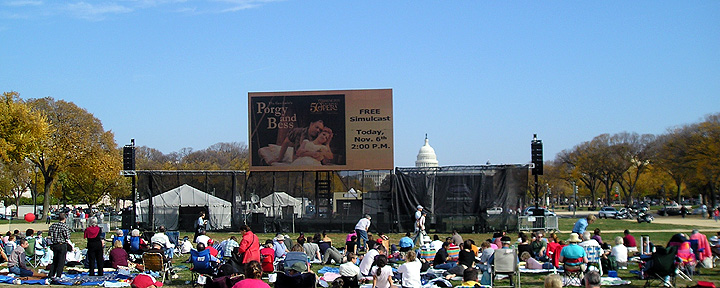
What a beautiful Indian summer afternoon for an opera on the Mall!
Around 10,000 people sat on blankets, rugs, lawn chairs, and even the grass on the National Mall and some 2,500 paying patrons watched in the Opera House at the Kennedy Center this afternoon when the Washington National Opera presented a matinee and simulcast performance of Gershwin's opera, Porgy and Bess as a part of WNO's 50th anniversary season. The Mall screen was set up about half way between the Capitol and the Washington Monument, between the Hirschorn Museum and the National Archives.

Not only were thousands of people watching, but there were quite a number of dogs in the audience! I've never taken Trevor to the opera (although I did have him as an actor in a musical once), so I'm sure he'll be barking his opinion when he sees this blog entry.
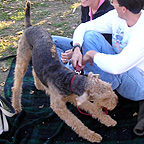
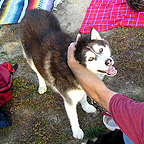
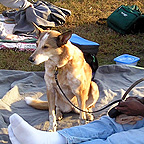
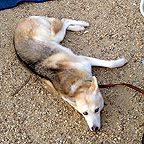
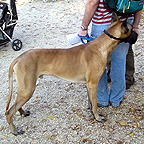
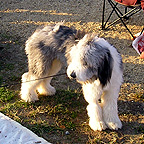
The mall crowd was a mix of young and old, black and white, families and singles, and everyone was in a great mood; many people brought picnic baskets of foods from fast food chicken to Whole Foods deli items to gourmet items prepared at home. I was pleasantly surprised at how engaged in the performance all those hundreds of small children were.
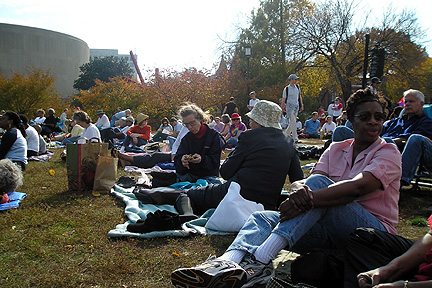
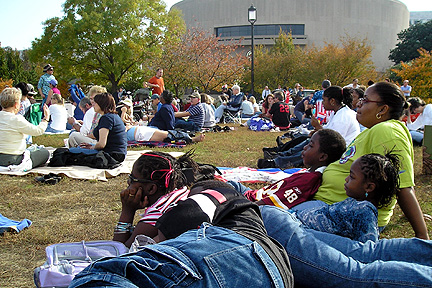
The show, slated for 2 p.m., started 8 minutes late. We got to hear a taped greeting from international opera star and conductor Placido Domingo, who is WNO's general director, then the board president of WNO greeted the audience at the Kennedy Center and the Mall crowd via simulcast, who introduced His Honor the Mayor of Washington for his greetings.
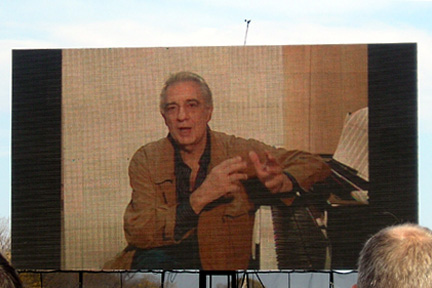
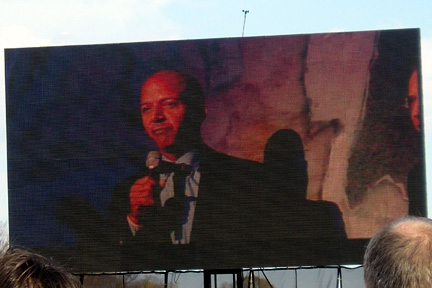
Finally, the music started. They were using four or five cameras at the Kennedy Center and mixing the feed there. One camera was in the back of the orchestra pit and gave the mall audience a very unusual glimpse of the conductor working with the pit musicians and showed some of the staging "secrets" like numbers posted along the pit wall to help the singers on stage find their places. The opening number of the opera is the well known song, "Summertime," sung by Laquita Mitchell as Clara, who was absolutely wonderful. I hope to see a lot of her in the future.
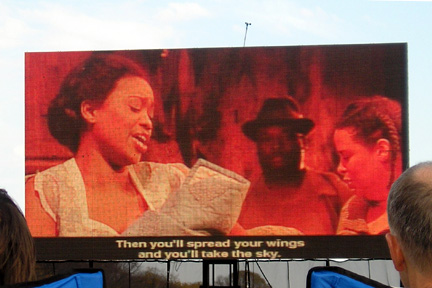
It was difficult to judge the sets and lighting from the broadcast. The show is set in a black tenement in Catfish Row, South Carolina, so the set appeared to be a multi-story structure of one room apartments for the various characters. Set pieces and props were brought in and removed by the chorus and supers as needed. Throughout the show, the acting and staging of the subsidiary characters and chorus was impressive, and my only complaint was that the two fight scenes were obviously fake "stage fighting," something which might not have been apparent in the opera house, but which read clearly in the camera closeups.
About 20 minutes into the show, D.C. native Gordon Hawkins as Porgy makes his entrance, followed eventually by Bess (sung by Indira Mahajan) and Crown (sung by Terry Cook). Porgy gets to sing "I Got Plenty O' Nuttin' " and then later he and Bess sing the duet "Bess, You Is My Woman Now." Hawkins was a strong singer and had a good stage presence, but I don't think he drew out enough audience sympathy for his role as the good crippled man. Mahajan's entrance threw me at first. I thought she looked Hispanic, rather than black, which was a bit of a non sequitur, since the Gershwin estate is adamant about the cast being all Africans (other than the detective, policeman, and their three officers) before they'll give permission for the show to be done. At intermission, I got a program, and saw Mahajan's name and thought then that she might be East Indian; I Googled her when I got home, though, and read that she's done a number of Porgy and Besses and has won several prizes for African-American singers, so I guess she's either light skinned or perhaps mixed blood. Ethnicity aside, she acted her role to the hilt, and I can imagine her in one of her other big roles, Musetta in La Boheme.
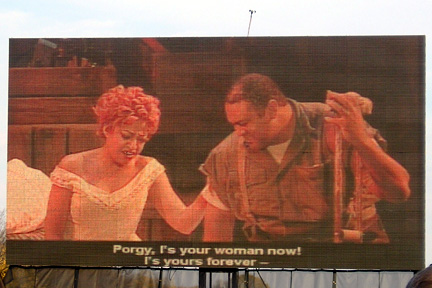
One of the interesting things about the score for this opera is that supporting cast members get a lot of the best songs and scenes, such as Clara's "Summertime," We also heard some outstanding performances this afternoon from the big voiced Angela Simpson in her powerful portrayal of Serena and Jermaine Smith as the wonderfully slimy Sportin' Life. Sportin' Life gets to sing the only other well-known song of the show, "It Ain't Necessarily So," near the end of the first act, and he had to do a lot of vigorous dancing during the show, including one number where he ended up on the floor in a split.
To accommodate the unusual situation on the Mall, there was a 25 minute intermission. This allowed people to use the row of 20 porta-potties along Constitution Avenue and the indoor facilities at one of the many Smithsonian museums in the area, and to visit the already in-place snack bars and vendors all up and down the Mall for the usual museum tourists. I was surprised we didn't have a lot of families leave at intermission, since the opera libretto is very adult: lots of drug use, sexually charged scenes, cursing, and adult themes.

During intermission we got to shift around a little bit. Most everyone was polite and cordial this afternoon, but about half an hour in to the show, some late-50-something woman in a Clinton-Gore '96 hat and her husband wandered in and sat initially on the ground, but eventually she got up in a folding chair, blocking the sight lines for a bunch of people who'd been sitting on the ground for an hour. During the show she squirmed around, dug through her bag, took off her shoes and played with cotton between her toes, took her jacket on and off, and took her pullover on and off to the horror of those around her as she held her arms up for the sweater removal process to reveal her sleeveless shell and the long, long hair under her arms!
The second act is interesting in that there are no well-known songs, since they were all sung in the first act. Clara and Bess each get a reprise of "Summertime," and Porgy has some "Plenty O' Nuttin' " reprise phrases, but most of the rest of the act is new and dramatic. This isn't one of those "and they lived happily ever after" operas.
At the end, the performers were warmly received by the people on the Mall. We were applauding then, as well as throughout the show, but I don't think the singers at the Kennedy Center were aware of it. It's a shame, since the Mall audience was more spontaneous and applauded for more things It was also neat seeing people on the Mall who'd probably never been to an opera before; many of them brought their black church experience with them and raised their arms at glorious moments, called out to the actors, laughed, and commented out loud about what was happening. The Kennedy Center crowd seemed much more restrained in comparison! The opera, which started about 2:10, was over at dusk, about 5:20.
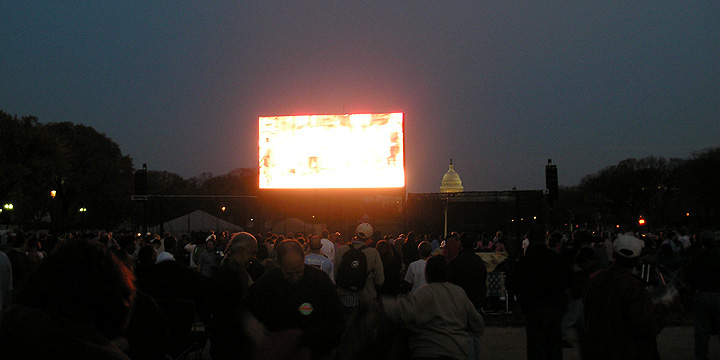
Clara, Serena, and Porgy got the most cheers from the Mall audience during curtain calls and conductor Wayne Marshall was very warmly received by the Kennedy Center audience. The Washington National Opera Orchestra played the jazzy, heavily syncopated score superbly and the African-American members of the Washington National Opera Chorus supplemented with some 30 supernumeraries acted convincingly, and I was especially impressed by all the child actors.
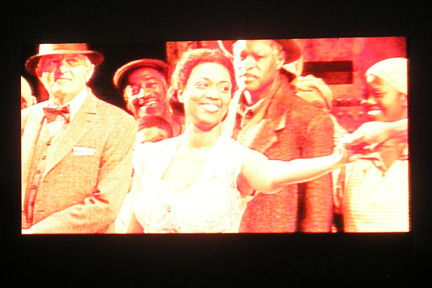
It was a wonderful afternoon to be in the Nation's Capital.
Saturday, November 5, 2005
FREE OPERA!!!
Who's going to be in D.C. tomorrow (Sunday) afternoon?
Washington National Opera is going to have a free simulcast performance of the Gershwins' Porgy and Bess on the Mall near the Capitol tomorrow at 2:00 p.m. Who wants to go with me?
The main performance will be going on at the Kennedy Center Opera House, where ticket prices (which are sold out anyway) range from $100 to $290. However, the simulcast will be FREE for those who want to brave the November weather (upper 60s to low 70s, slight chance of rain) and watch the opera on an 18' x 32' LED video screen.
Porgy and Bess is probably the best known American opera, featuring lots of jazzy and bluesy melodies and memorable tunes even non-operaphiles will recognize such as "Summertime," "It Ain't Necessarily So," and "Bess, You Is My Woman Now." It's not often performed live in its entirety though, so this is a rare treat.
So, I'm thinking about maybe putting together some blankets and a picnic basket......anybody interested in going? Call, email, or comment ASAP, ok?
Washington National Opera is going to have a free simulcast performance of the Gershwins' Porgy and Bess on the Mall near the Capitol tomorrow at 2:00 p.m. Who wants to go with me?
The main performance will be going on at the Kennedy Center Opera House, where ticket prices (which are sold out anyway) range from $100 to $290. However, the simulcast will be FREE for those who want to brave the November weather (upper 60s to low 70s, slight chance of rain) and watch the opera on an 18' x 32' LED video screen.
Porgy and Bess is probably the best known American opera, featuring lots of jazzy and bluesy melodies and memorable tunes even non-operaphiles will recognize such as "Summertime," "It Ain't Necessarily So," and "Bess, You Is My Woman Now." It's not often performed live in its entirety though, so this is a rare treat.
So, I'm thinking about maybe putting together some blankets and a picnic basket......anybody interested in going? Call, email, or comment ASAP, ok?
Saturday, October 22, 2005
Movie review: Latter Days
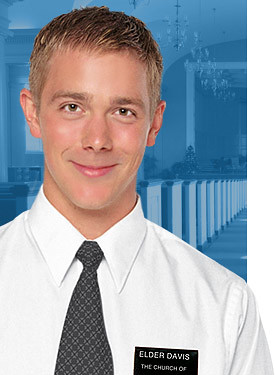
Steve Sandvoss as Elder Aaron Davis
I hate movies that make me cry.
Ordinarily, I'm not a sentimental person. In fact, I can be very cold, calculating, and callous when appropriate. Deaths don't bother me, and I used to make lots of money singing at funerals, many of which had mourners bawling their eyes out. So, I was dismayed this afternoon when I watched a DVD of the 2004 movie Latter Days and found myself sobbing and in tears by the end of the movie.
What's worse, when I watched the music video of the song from the movie "3 a.m.," I started crying again!
New actor Steve Sandvoss stars as Elder Aaron Davis, a young Mormon doing his church mission with three other homophobic missionaries in Los Angeles, including Ryder, played by Joseph Gordon-Levitt of Third Rock fame. They end up in an apartment living next to Christian, a hot gay waiter and party boy played by former Guiding Light actor Wes Ramsey, and his roommate Julie, played by model/singer Rebekah Jordan. Once Julie discovers their new neighbors are missionaries, she and their restaurant colleagues make a bet with Christian that he can't have sex with one of the Mormon boys.
As luck would have it, Aaron is already struggling with his homosexual urges and his commitments to his church, so it doesn't take long for Christian to make inroads. Aaron resists his devils, though, and challenges Christian about his promiscuous lifestyle, asking if any of his love making has any meaning whatsoever, or if it's just as casual as shaking hands. Problems ensue when Aaron is discovered, sent home in disgrace, and excommunicated from his church (a very big deal in Mormon country!). Christian has to deal with the consequences of his bet and his actions ruining Aaron's life, only to realize that he fell in love with Aaron.
Aaron's struggle reconciling his homosexuality with his church and his family was heartwrenching. The more he looked at Christian, the more he turned to his Bible and his Book of Mormon, and he was certainly the most serious and the most committed of his group of missionaries. He typified the struggles that gay Christians of all denominations have when they discover their sexuality and find themselves in direct conflict with their religion.
Jacquelyn Bissett served as the matriarch of the film, acting as proprietress and mother confessor at the restaurant where Christian and Julie work. Actor Eric Palladino (E.R., Over There) had a small but powerful role as Keith, an AIDS patient Christian delivered lunches to and visited.
Now, I have to say that casting Steve Sandvoss as Aaron was a stroke of genius. That boy is tall, handsome, blond, cute, soft-spoken, thoughtful, and looked very much the freshly-scrubbed Mormon boy. He was breathtaking. When he smiled, my heart just melted! His voice was so gentle, so full of love. How could a family or a church reject a boy like that?
I happen to be a Christian, too, but I've been blessed by being Episcopalian my whole life, where gays are tolerated and accepted by most ministers and members. At the same time, I've had gay friends from other denominations who've been kicked out of their homes, excommunicated, shunned, forced to endure exorcisms, sent to clinics to be "cured," and other atrocities, all in the name of a religion that has as its primary tenant "Love." If they reject a person God made gay, how is that loving God with their whole heart and soul? If they persecute someone for being gay, how is that loving their neighbor like themselves? It just makes me so very, very sad.
While officially categorized as a "gay movie, Latter Days could equally be grouped with Christian movies or love stories. It's certainly one of the finest "gay" movies I've ever watched, and I highly recommend it to all gays, Mormons (and all Christians), and their families and friends. There are some sex scenes which are quite romantic and hot, but tamer than what one might see on a Queer as Folk episode, so keep that in mind when you are showing it to family members. This is a movie that needs to be seen, and needs to be made available to older Christian teenagers who may be struggling with their sexuality and their faith.
And be sure to bring a big box of Kleenex.
Tuesday, October 18, 2005
Poetry I can understand
Back when I was teaching liberal arts classes on the collegiate level, I always had a certain degree of discomfort when I had to lecture on poetry. Poetry has never been a favorite of mine.
Of course, some of it isn't bad. When it has a rhythm to it, it rhymes, and it's rhetorical, it can be ok. I like story poems, thing that talk about something my simple mind can understand. In elementary school, I remember being introduced to poems like "Casey at the Bat" and my third grade teacher's favorite poem, Joyce Kilmer's "Trees" (the first few lines of which I still remember). Then in junior high, we got to fun things like Coleridge's "Rime of the Ancient Mariner" and all those wonderful poems by Edgar Allen Poe Quoth The Raven Nevermore. High school got us to the heavy duty poets, like Will Shakespeare, Elizabeth Barrett Browning, and Geoffrey Chaucer. Some of these things were actually fun, they painted word pictures, and most importantly to me, they were singable; the art songs I was singing in music competitions were all poems. Even in Boy Scouts and our secret Order of the Arrow rituals, some of our longer initiation lectures were in iambic pentameter blank verse, and that was cool.
Then I got to college. In my freshman honors English class, our professor was not concerned about our ability to write a coherent essay (that skill was the primary criterion for admission to that section), so he had us read and discuss a lot of new, modern literature: short stories, essays, and........poetry. And therein was the problem.
Modern poetry. It was trash. It was garbage. It made no sense. It intentionally violated all the "rules" just for the sake of violating the rules. It was forced on us, because if we didn't like it, we weren't politically correct; we weren't supporting all the "victimized" poets—victimized because they were womyn or they were black or they were Chicano or they were poor or they were rich or they were country or they were urban or they were homeless or they were socially awkward or they were just a bad poet. And the hideous, uninspired, worthless modern poetry went on and on and on.
It's gotten to the point now where a serious poet dare not write a poem that rhymes for fear of being labeled old-fashioned and out of date.
I remember preparing my first English Composition 2 syllabus. I saw our departmental master outline mandate that we have a unit on poetry analysis; I got a sinking feeling in the pit of my stomach. What would I say? What would I teach? What if I had a poetry lover in my class? What would I do if a student actually had the intellectual curiosity to ask why a bad modern "poem" had been considered good enough to be in the anthology textbook?
Well, I managed to dodge those bullets. Yet, still, no end of study, reading, and preparation helped me answer to me the hard questions, the questions about modern poetry, the issues I could distill to a single, simple question: Huh?
Some of my friends like poetry. In fact, some of them actually write poetry. The "literature" kind. Occasionally our conversations will drift to the fact they have written some new poem, and I am gripped with fear: what if they want me to read their poem? Is it any good? Will I hate it? Is it weird? Or just maudlin? Can I agree with them how that editor/judge/selection committee really screwed them over by not giving them the first place prize?
Then, this morning I made a remarkable—a wonderous—discovery!
I ran across a brand new poem which flipped on the modern poetry light switch for me. Now, I can face my students. Now, I can be an English snob, too. Now, I can avoid changing the subject at cocktail parties dotted with literary people.
The exciting, young poet A. P. Quinn (who was educated at a small, no-name, Presbyterian liberal arts college with some help from the English modernists at the University of York in the north of England) has written a piece, satirical perhaps—but it's modern, so it may be deadly serious—which explains and sums up modern poetry into a single, understandable concept. It makes sense out of all those poetry books on the remainder tables at Barnes and Noble. It gives meaning to the recitations of those earnest young men and women in the coffee bars. This is the sort of breakthrough poem which jumpstarts new careers. This is the work which sets the stage for a new poet laureate (after all, Maya Angelou is almost 80!). I'm being very serious about this, and I hope my colleagues in English departments and editorial suites around the country read and cherish this poem as a brilliant primer on modern poetry.
Here is Quinn's work (Quinn doesn't believe in copyright laws, so feel free to reproduce it at will):
Of course, some of it isn't bad. When it has a rhythm to it, it rhymes, and it's rhetorical, it can be ok. I like story poems, thing that talk about something my simple mind can understand. In elementary school, I remember being introduced to poems like "Casey at the Bat" and my third grade teacher's favorite poem, Joyce Kilmer's "Trees" (the first few lines of which I still remember). Then in junior high, we got to fun things like Coleridge's "Rime of the Ancient Mariner" and all those wonderful poems by Edgar Allen Poe Quoth The Raven Nevermore. High school got us to the heavy duty poets, like Will Shakespeare, Elizabeth Barrett Browning, and Geoffrey Chaucer. Some of these things were actually fun, they painted word pictures, and most importantly to me, they were singable; the art songs I was singing in music competitions were all poems. Even in Boy Scouts and our secret Order of the Arrow rituals, some of our longer initiation lectures were in iambic pentameter blank verse, and that was cool.
Then I got to college. In my freshman honors English class, our professor was not concerned about our ability to write a coherent essay (that skill was the primary criterion for admission to that section), so he had us read and discuss a lot of new, modern literature: short stories, essays, and........poetry. And therein was the problem.
Modern poetry. It was trash. It was garbage. It made no sense. It intentionally violated all the "rules" just for the sake of violating the rules. It was forced on us, because if we didn't like it, we weren't politically correct; we weren't supporting all the "victimized" poets—victimized because they were womyn or they were black or they were Chicano or they were poor or they were rich or they were country or they were urban or they were homeless or they were socially awkward or they were just a bad poet. And the hideous, uninspired, worthless modern poetry went on and on and on.
It's gotten to the point now where a serious poet dare not write a poem that rhymes for fear of being labeled old-fashioned and out of date.
I remember preparing my first English Composition 2 syllabus. I saw our departmental master outline mandate that we have a unit on poetry analysis; I got a sinking feeling in the pit of my stomach. What would I say? What would I teach? What if I had a poetry lover in my class? What would I do if a student actually had the intellectual curiosity to ask why a bad modern "poem" had been considered good enough to be in the anthology textbook?
Well, I managed to dodge those bullets. Yet, still, no end of study, reading, and preparation helped me answer to me the hard questions, the questions about modern poetry, the issues I could distill to a single, simple question: Huh?
Some of my friends like poetry. In fact, some of them actually write poetry. The "literature" kind. Occasionally our conversations will drift to the fact they have written some new poem, and I am gripped with fear: what if they want me to read their poem? Is it any good? Will I hate it? Is it weird? Or just maudlin? Can I agree with them how that editor/judge/selection committee really screwed them over by not giving them the first place prize?
Then, this morning I made a remarkable—a wonderous—discovery!
I ran across a brand new poem which flipped on the modern poetry light switch for me. Now, I can face my students. Now, I can be an English snob, too. Now, I can avoid changing the subject at cocktail parties dotted with literary people.
The exciting, young poet A. P. Quinn (who was educated at a small, no-name, Presbyterian liberal arts college with some help from the English modernists at the University of York in the north of England) has written a piece, satirical perhaps—but it's modern, so it may be deadly serious—which explains and sums up modern poetry into a single, understandable concept. It makes sense out of all those poetry books on the remainder tables at Barnes and Noble. It gives meaning to the recitations of those earnest young men and women in the coffee bars. This is the sort of breakthrough poem which jumpstarts new careers. This is the work which sets the stage for a new poet laureate (after all, Maya Angelou is almost 80!). I'm being very serious about this, and I hope my colleagues in English departments and editorial suites around the country read and cherish this poem as a brilliant primer on modern poetry.
Here is Quinn's work (Quinn doesn't believe in copyright laws, so feel free to reproduce it at will):
Erotica: A Meditation on Autumn Leaves
by A. P. Quinn
I am a poet, you
See because I can do
Pointless enjamb-
Ments that make no sense,
And I write about autumn and stuff,
Like leaves and birdies and
The autumn leaves and birdies
And nature, since nature is so poetic, ya!
But of course I will never even attempt
To utilize a single musical device since
Poems actually sounding beautiful is so
Last era. Bush sucks.
Fuck. Ooh, I said fuck, isn’t
That shocking?
Oh and I can’t use any words that are more than
Two syllables because I’m populist or something
Except, oh look, I used three-syllable words
Because I’m a master of irony.
Starbucks. Because that one contemporary pop
culture reference is so important.
Worship me.
Where’s my Pulitzer, fuckers?
Saturday, October 15, 2005
What's the deal about bow ties?
Setting: The Concert Hall of the Kennedy Center for the Performing Arts.
Action: The ninety-eight or so members of the National Symphony Orchestra, over half of whom are male, are sitting on stage, ready to play a concert. The men are all attired in tail coats with formal white bow ties.
Enigma: Famed conductor and NSO musical director Leonard Slatkin enters and takes his place at the podium, wearing a tuxedo suit with a black bow tie. Huh? What is wrong here?
Enigma 2: Featured soloist, the internationally renowned violinist Pinchas Zuckerman, makes his entrance. He is wearing a tail coat, but he has on a white shirt with a banded collar and no tie. What is going on here?
Thus, we have the rather disconcerting issue which prefaced tonight's National Symphony Orchestra concert. The music was quite fine (more on that later), but I found the mystery of the ties to be quite engrossing (that plus the mystery of why two different styles of chairs were being used haphazardly for the orchestra).
Things became more complicated at the intermission. As I headed back into the hall, who should I run in to but the conductor of the Bartlesville Symphony and the former executive director of the OK Mozart International Festival, for both of whose groups I've sung in the past. And, of course, as I encountered each of them, they both had to run up to me to say hello. As it turns out, they were there with a tour group of about 30 people from northeastern Oklahoma. Which brings me to enigma 3, which is, why is it that everywhere I go, I always manage to run in to people from back home? Those of you from small towns know how quickly the gossip and news travels. In fact, it was not at all uncommon when I was in high school and college for my parents to have heard where I was and with whom before I even got home. Well, tonight when I got home from the concert and dinner, I was surprised that I didn't have an email from my mother wanting to know who I was with at the Kennedy Center tonight and why wasn't I wearing a tie!
What's the deal about ties?
Anyway, I had a lovely evening tonight after an unexpected invitation this afternoon from the charming and gracious Fr. Steven, who had an extra ticket to tonight's concert. I'll blame him for my decision to be tieless tonight. He was determined to shed his suit and tie and go in a glen plaid blazer and blue jeans with no tie, so I took off my tie, blazer, and khakis I'd been wearing earlier today and opted to wear a green cotton sweater over an ecru Oxford-cloth button-down with some navy blue Armani trousers and my too-small-but-ever-so-fashionable black Ferragamo loafers. But no tie.
It was also a pleasure to see Mr. Zuckerman again. About five years ago, I sang a world-premiere opera with his daughter that Ransom Wilson and Jean-Michel Damase had put together. Haven't heard a thing about her since, so I don't know if she is still singing or not. Unfortunately, we didn't have backstage passes, so I didn't get a chance to go back and talk to him.
The concert opened with an orchestral transcription of Bach's "Chaconne" from Partita in D minor for Unaccompanied Violin, BWV 1004. It took the orchestra about a minute or two to get warmed up, but eventually they got things together. I often think they don't really play well for Slatkin, even though he's been their music director for ten years. Tonight was the first time I've seen him lead the orchestra from a vantage point where I could really watch him conduct—we were on row G in the lower orchestra right section. I have to say he looks like he's extremely difficult to follow! He uses a lot of curved and circular conducting motions (they really weren't regular enough to call them "patterns") with the tip of his baton making a lot of extraneous motions. Since he doesn't use a regular vertical conducting pattern, I couldn't quite determine the ictus of the beat, and even on those limited occasions when he did have clear down beats, the orchestra was definitely not playing at the bottom of the beat.
The second work of the first half of the concert was fascinating. When I saw "Concerto for Violin and Orchestra by Alban Berg" on the program, I cringed a little, since Berg was a protègé of Arnold Schönberg and he is known for his atonal works and 12-note serialism. This particular concerto was composed in the months shortly before Berg's death in 1935. As it turned out, though, this was the best part of the entire evening's concert. The violin part was fiendishly difficult, requiring Zuckerman to play the random intervals of atonal music in some sections, in other sections to play two notes simultaneously, and in yet other sections to play pizzicato (plucked) notes whilst simultaneously playing long melodic lines with slow bowing technique. The concerto was about 25 minutes long, but it seemed like the time just flew by. It was a brilliant performance by both NSO and Zuckerman.
Intermission was interesting, aside from the aforementioned encounters with Oklahomans. By the time we made our way out to the lobby, got in line for a cocktail, and were almost up to the head of the line, some ushers started ringing the bell and announced that the second half was starting soon and there would be no late seating once they started. Well, we didn't want to have to swallow our cocktails in one gulp, so we gave up and went back inside without our alcoholic fortification for the Berlioz to come.
The entire second half of the concert was devoted to a single work, Hector Berlioz's infrequently heard Harold in Italy, Op. 16. Harold is, in essence, a symphony based on Lord Byron's epic poem Childe Harold's Pilgrimage with four movements: I. Harold in the Mountains. Scenes of Melancholy, Happiness, and Joy. II. March of the Pilgrims Singing Their Evening Prayer. III. Serenade of an Abruzzi Mountaineer to His Mistress. IV. Orgy of the Brigands. Reminiscences of Earlier Scenes.
Berlioz, who is probably best known for his tone poem Symphonie Fantastique, tends to write in a very effusive, melodramatic way, and Harold was no exception. The interesting thing about this work, though, was an obbligato part for solo viola, and soloist Zuckerman switched to a viola for this portion of the concert. The work, though, is very formulaic, and the "big ending" met with the intended crowd approval. Tonight's audience was an interesting mix of musical enthusiasts and musical sophicates, with about half the audience standing for the final ovations and about half the audience rather pointedly and stubbornly remaining in their seats. Given what the performers had to work with, though, the symphony was good.
There is one more performance of this particular concert program remaining on tomorrow (Saturday) night, and I encourage everyone to go hear it, particularly for the Berg concerto.
Action: The ninety-eight or so members of the National Symphony Orchestra, over half of whom are male, are sitting on stage, ready to play a concert. The men are all attired in tail coats with formal white bow ties.
Enigma: Famed conductor and NSO musical director Leonard Slatkin enters and takes his place at the podium, wearing a tuxedo suit with a black bow tie. Huh? What is wrong here?
Enigma 2: Featured soloist, the internationally renowned violinist Pinchas Zuckerman, makes his entrance. He is wearing a tail coat, but he has on a white shirt with a banded collar and no tie. What is going on here?
Thus, we have the rather disconcerting issue which prefaced tonight's National Symphony Orchestra concert. The music was quite fine (more on that later), but I found the mystery of the ties to be quite engrossing (that plus the mystery of why two different styles of chairs were being used haphazardly for the orchestra).
Things became more complicated at the intermission. As I headed back into the hall, who should I run in to but the conductor of the Bartlesville Symphony and the former executive director of the OK Mozart International Festival, for both of whose groups I've sung in the past. And, of course, as I encountered each of them, they both had to run up to me to say hello. As it turns out, they were there with a tour group of about 30 people from northeastern Oklahoma. Which brings me to enigma 3, which is, why is it that everywhere I go, I always manage to run in to people from back home? Those of you from small towns know how quickly the gossip and news travels. In fact, it was not at all uncommon when I was in high school and college for my parents to have heard where I was and with whom before I even got home. Well, tonight when I got home from the concert and dinner, I was surprised that I didn't have an email from my mother wanting to know who I was with at the Kennedy Center tonight and why wasn't I wearing a tie!
What's the deal about ties?
Anyway, I had a lovely evening tonight after an unexpected invitation this afternoon from the charming and gracious Fr. Steven, who had an extra ticket to tonight's concert. I'll blame him for my decision to be tieless tonight. He was determined to shed his suit and tie and go in a glen plaid blazer and blue jeans with no tie, so I took off my tie, blazer, and khakis I'd been wearing earlier today and opted to wear a green cotton sweater over an ecru Oxford-cloth button-down with some navy blue Armani trousers and my too-small-but-ever-so-fashionable black Ferragamo loafers. But no tie.
It was also a pleasure to see Mr. Zuckerman again. About five years ago, I sang a world-premiere opera with his daughter that Ransom Wilson and Jean-Michel Damase had put together. Haven't heard a thing about her since, so I don't know if she is still singing or not. Unfortunately, we didn't have backstage passes, so I didn't get a chance to go back and talk to him.
The concert opened with an orchestral transcription of Bach's "Chaconne" from Partita in D minor for Unaccompanied Violin, BWV 1004. It took the orchestra about a minute or two to get warmed up, but eventually they got things together. I often think they don't really play well for Slatkin, even though he's been their music director for ten years. Tonight was the first time I've seen him lead the orchestra from a vantage point where I could really watch him conduct—we were on row G in the lower orchestra right section. I have to say he looks like he's extremely difficult to follow! He uses a lot of curved and circular conducting motions (they really weren't regular enough to call them "patterns") with the tip of his baton making a lot of extraneous motions. Since he doesn't use a regular vertical conducting pattern, I couldn't quite determine the ictus of the beat, and even on those limited occasions when he did have clear down beats, the orchestra was definitely not playing at the bottom of the beat.
The second work of the first half of the concert was fascinating. When I saw "Concerto for Violin and Orchestra by Alban Berg" on the program, I cringed a little, since Berg was a protègé of Arnold Schönberg and he is known for his atonal works and 12-note serialism. This particular concerto was composed in the months shortly before Berg's death in 1935. As it turned out, though, this was the best part of the entire evening's concert. The violin part was fiendishly difficult, requiring Zuckerman to play the random intervals of atonal music in some sections, in other sections to play two notes simultaneously, and in yet other sections to play pizzicato (plucked) notes whilst simultaneously playing long melodic lines with slow bowing technique. The concerto was about 25 minutes long, but it seemed like the time just flew by. It was a brilliant performance by both NSO and Zuckerman.
Intermission was interesting, aside from the aforementioned encounters with Oklahomans. By the time we made our way out to the lobby, got in line for a cocktail, and were almost up to the head of the line, some ushers started ringing the bell and announced that the second half was starting soon and there would be no late seating once they started. Well, we didn't want to have to swallow our cocktails in one gulp, so we gave up and went back inside without our alcoholic fortification for the Berlioz to come.
The entire second half of the concert was devoted to a single work, Hector Berlioz's infrequently heard Harold in Italy, Op. 16. Harold is, in essence, a symphony based on Lord Byron's epic poem Childe Harold's Pilgrimage with four movements: I. Harold in the Mountains. Scenes of Melancholy, Happiness, and Joy. II. March of the Pilgrims Singing Their Evening Prayer. III. Serenade of an Abruzzi Mountaineer to His Mistress. IV. Orgy of the Brigands. Reminiscences of Earlier Scenes.
Berlioz, who is probably best known for his tone poem Symphonie Fantastique, tends to write in a very effusive, melodramatic way, and Harold was no exception. The interesting thing about this work, though, was an obbligato part for solo viola, and soloist Zuckerman switched to a viola for this portion of the concert. The work, though, is very formulaic, and the "big ending" met with the intended crowd approval. Tonight's audience was an interesting mix of musical enthusiasts and musical sophicates, with about half the audience standing for the final ovations and about half the audience rather pointedly and stubbornly remaining in their seats. Given what the performers had to work with, though, the symphony was good.
There is one more performance of this particular concert program remaining on tomorrow (Saturday) night, and I encourage everyone to go hear it, particularly for the Berg concerto.
Thursday, October 13, 2005
Ushering for charity
What would you do if you discovered that you had been cloned?
How many clones? Well, a number.....
And thus, we have the plot of Caryl Churchill's play A Number, one of the two current productions at the Studio Theater in Washington, D.C.
A Number is a fairly new play, only about three years old, and it certainly presents modern issues requiring some deep thought on the part of theatergoers. Now, the Studio Theater's promotional materials said that this play examined "the complex and often heart-wrenching relationship between father and son, as Churchill boldly examines the personal cost of powerful new technology;" however, I found it presented a more troubling and more controversial issue: that of nature versus nurture. What happens when you have genetically identical children raised apart in completely different home environments? Can you blame a parent for the criminal proclivities of a child? Are some parents so unfit to rear children that the children should be placed at birth with different, "better" parents?
There are many aspects of the play I would love to discuss, but I can't mention them here, because it would give away too much of the surprising plot twists of this engaging play.
Two actors comprised the entire cast of the show, with Tom Story as the early 20-something young man and Ted van Griethuysen as his father. They were both excellent. The only thing I didn't like was the director's decision to have the two actors speak with faux-British accents. Now, Churchill is an English playwright, and she used a couple of English expressions in the script, but I think I would have made the decision to Americanize those limited expressions (for example, saying "in the hospital" instead of "in hospital") and then the actors wouldn't have had to struggle with their mixed English accents. I'm sure the vast majority of the audience didn't notice, but one of my hobbies when I was up at Oxford was trying to learn the various British regional accents and dialects. So, I notice.
Studio Theater has two theaters inside. We were in the Mead Theater, which is an intimate space seating about 200 with a thrust stage, meaning there are seats on three sides of the performance space. The design of this production also meant there was no "curtain," and the set was in full view of the audience at all times. The main stage had a series of vertical screens which later would be used to project pictures of actor Story. The thrust was covered with a large square of shabby, grey, shag carpeting. A large, contemporary, Mies van der Rohe-inspired, Barcelona armchair with well-worn black leather upholstery sat in the middle of the carpet with a big glass ashtray on the floor to the side. Just prior to the audience being let in, actor van Griethuysen, looking disheveled and unkempt in a rumpled, cheap, blue chalkstripe suit and open-collared wrinkled shirt, took his place in the chair, facing upstage, and began smoking cigarettes. Story would appear in blue jeans and a white t-shirt.
This performance was also the debut of my volunteer ushering for the Studio Theater. It was a lot of fun.
I signed up to usher, thinking this would be a good way to meet new people, but I was a little disappointed that most all of the volunteers were women. My hopes rose a bit when the one other man walked into the lobby—a cute, trim, 30-something guy with curly dark hair, a European-cut suit, and a $200 custom shirt from Hong Kong who works for the World Bank—but then he went straight up to one of the female volunteers, his girlfriend. Alas. Then I noticed his shabby shoes and I knew for sure he'd be paying more attention to her than me. Anyway, they had twelve volunteers, one who ran the coat check, one who sold drinks at the concession stand, two who took tickets, one who was a "greeter" in the lobby, four who passed out programs and helped patrons find their seats, and three extras they decided they didn't need, so they sent those three volunteers to go watch the other play in the house, Hilda. Once all the patrons were seated, we got seats on the left side of the thrust on row A. Easy work for a free ticket to professional theater.
One of the nice things about sitting right up front at plays and other performances (I love being on the first or second row) is you get to see the true expression and emotion on the faces of the actors. You can see the sweat dripping off the tips of their noses. And, you can tell if they are truly "feeling" the emotions they are portraying, or if they are just doing stage business. Thus, that is why I like the seats up front, even though sometimes one can't see the big picture of the entire stage. One of the other interesting things about sitting there for this production was watching the sprays of saliva spewing from the actors' mouths as they worked to enunciate all of their words clearly and sharply—truly spitting out their lines.
A Number only runs through this Sunday, so if you like theater and drama, I'd urge you to hurry to the Studio Theater and see this production.
How many clones? Well, a number.....
And thus, we have the plot of Caryl Churchill's play A Number, one of the two current productions at the Studio Theater in Washington, D.C.
A Number is a fairly new play, only about three years old, and it certainly presents modern issues requiring some deep thought on the part of theatergoers. Now, the Studio Theater's promotional materials said that this play examined "the complex and often heart-wrenching relationship between father and son, as Churchill boldly examines the personal cost of powerful new technology;" however, I found it presented a more troubling and more controversial issue: that of nature versus nurture. What happens when you have genetically identical children raised apart in completely different home environments? Can you blame a parent for the criminal proclivities of a child? Are some parents so unfit to rear children that the children should be placed at birth with different, "better" parents?
There are many aspects of the play I would love to discuss, but I can't mention them here, because it would give away too much of the surprising plot twists of this engaging play.
Two actors comprised the entire cast of the show, with Tom Story as the early 20-something young man and Ted van Griethuysen as his father. They were both excellent. The only thing I didn't like was the director's decision to have the two actors speak with faux-British accents. Now, Churchill is an English playwright, and she used a couple of English expressions in the script, but I think I would have made the decision to Americanize those limited expressions (for example, saying "in the hospital" instead of "in hospital") and then the actors wouldn't have had to struggle with their mixed English accents. I'm sure the vast majority of the audience didn't notice, but one of my hobbies when I was up at Oxford was trying to learn the various British regional accents and dialects. So, I notice.
Studio Theater has two theaters inside. We were in the Mead Theater, which is an intimate space seating about 200 with a thrust stage, meaning there are seats on three sides of the performance space. The design of this production also meant there was no "curtain," and the set was in full view of the audience at all times. The main stage had a series of vertical screens which later would be used to project pictures of actor Story. The thrust was covered with a large square of shabby, grey, shag carpeting. A large, contemporary, Mies van der Rohe-inspired, Barcelona armchair with well-worn black leather upholstery sat in the middle of the carpet with a big glass ashtray on the floor to the side. Just prior to the audience being let in, actor van Griethuysen, looking disheveled and unkempt in a rumpled, cheap, blue chalkstripe suit and open-collared wrinkled shirt, took his place in the chair, facing upstage, and began smoking cigarettes. Story would appear in blue jeans and a white t-shirt.
This performance was also the debut of my volunteer ushering for the Studio Theater. It was a lot of fun.
I signed up to usher, thinking this would be a good way to meet new people, but I was a little disappointed that most all of the volunteers were women. My hopes rose a bit when the one other man walked into the lobby—a cute, trim, 30-something guy with curly dark hair, a European-cut suit, and a $200 custom shirt from Hong Kong who works for the World Bank—but then he went straight up to one of the female volunteers, his girlfriend. Alas. Then I noticed his shabby shoes and I knew for sure he'd be paying more attention to her than me. Anyway, they had twelve volunteers, one who ran the coat check, one who sold drinks at the concession stand, two who took tickets, one who was a "greeter" in the lobby, four who passed out programs and helped patrons find their seats, and three extras they decided they didn't need, so they sent those three volunteers to go watch the other play in the house, Hilda. Once all the patrons were seated, we got seats on the left side of the thrust on row A. Easy work for a free ticket to professional theater.
One of the nice things about sitting right up front at plays and other performances (I love being on the first or second row) is you get to see the true expression and emotion on the faces of the actors. You can see the sweat dripping off the tips of their noses. And, you can tell if they are truly "feeling" the emotions they are portraying, or if they are just doing stage business. Thus, that is why I like the seats up front, even though sometimes one can't see the big picture of the entire stage. One of the other interesting things about sitting there for this production was watching the sprays of saliva spewing from the actors' mouths as they worked to enunciate all of their words clearly and sharply—truly spitting out their lines.
A Number only runs through this Sunday, so if you like theater and drama, I'd urge you to hurry to the Studio Theater and see this production.
Sunday, October 9, 2005
Review: Hauptmann
This evening you will be executed for murder; it was a notorious murder; it made world-wide headlines, as did your trial and conviction.
The only problem is, you didn't do it.
How would you act? How would you feel? Nervous? Scared? Angry?
Last night, we saw local thespian Michael Kharfen answer that question with his impressive performance in the title role of Port City Playhouse's production of Hauptmann at the Lee Center for the Performing Arts in Alexandria. Hauptmann is the story of Bruno Richard Hauptmann, the German immigrant who was convicted and executed on April 3, 1936, for allegedly kidnapping and murdering the infant son of famed transatlantic aviator Charles Lindbergh.
John Logan, more popularly known as the writer of the recent Howard Hughes movie The Aviator and the screenplay writer of the blockbuster motion pictures Star Trek: Nemesis and Gladiator, wrote this play, which made its premiere in 1986, joining an ever growing body of writers doing plays, movies, and books questioning the Hauptmann verdict, proclaiming Hauptmann's innocence, and suggesting that the public furor for an arrest and conviction in the Lindbergh baby case led to Hauptmann being framed and tried by desparate New Jersey police and prosecutors.
This was a stark play. It met all of the demands of Greek tragedy, complete with catharsis for those people who still unequivocally advocate for capital punishment. DId Hauptmann do it? We really don't know, and Logan, who wrote the play from Hauptmann's perspective, says that he doesn't take sides. But there is certainly plenty for us to think about.
The spare set consisted of a simple raised platform center stage which at times represented Hauptmann's cell and at other times was the trial judge's bench. Three simple, ladder-back chairs flanked each side of the platform. Colors were all black and dark greys. The entire cast came out at the begining of the play, Hauptmann dressed in prison dungarees and the other characters played by two women and four men dressed in dark grey prison guard uniforms. Large, dark grey mesh boxes were upstage of each chair to hold the collateral temporary props for each actor. As Hauptmann narrated his story, each actor transformed with a simple costume prop to play various other characters: a fedora and camera for a reporter, gown and gavel for the judge, bomber jacket and white scarf for Lindbergh. a crocheted shawl for Hauptmann's wife.
The burden of the play fell to Kharfen, as he was talking and acting constantly throughout the grueling, two act play. He chose to make Hauptmann a nervous, slightly frenetic man with some consistent hand mannerisms and slight shaking and a strong, realistic, German accent. I'd only met Kharfen briefly several weeks ago, so I couldn't recall all of his normal personal mannerisms, and I wasn't sure how much of his acting was him and how much was for the character. In those moments when he broke into playing Hauptmann's defense attorney, though, Kharfen was a completely different person, and I immediately knew he was "acting" for Hauptmann. There were a couple of brief moments of over-the-top histrionics, but I blame those tiny glitches more on the director than the actor. Kharfen wasn't wearing face makeup as did the other players, so his activity and the heat of the stage lights quickly had his face glowing—and eventually dripping—with perspiration. You know, if I were about to be executed in a couple of hours, I might be having a little perspiration, myself! Kharfen normally directs plays around here, but I certainly think he should do more frequent acting.
Port City Playhouse is a community theater. One of the problems with community theater is there is often a great disparity in talent between leading actors and supporting cast. While the six supporting characters each had some very good moments, it was very apparent that this was community theater and they were doing amateur acting, probably overly highlighted by Kharfen's talents. They worked together as a cohesive cast, though, so if one could ignore some of the amateur issues, it was really quite a good ensemble cast. The two women, particularly, did excellent jobs in creating completely different characters for the different roles they played.
Hauptmann has three more performances in this run, on the 11th, 14th, and 15th. If you're a fan of drama and tragedy, be sure to drop in. Tickets are only $14, and that includes free cups of soda and some pretzels during the intermission.
The only problem is, you didn't do it.
How would you act? How would you feel? Nervous? Scared? Angry?
Last night, we saw local thespian Michael Kharfen answer that question with his impressive performance in the title role of Port City Playhouse's production of Hauptmann at the Lee Center for the Performing Arts in Alexandria. Hauptmann is the story of Bruno Richard Hauptmann, the German immigrant who was convicted and executed on April 3, 1936, for allegedly kidnapping and murdering the infant son of famed transatlantic aviator Charles Lindbergh.
John Logan, more popularly known as the writer of the recent Howard Hughes movie The Aviator and the screenplay writer of the blockbuster motion pictures Star Trek: Nemesis and Gladiator, wrote this play, which made its premiere in 1986, joining an ever growing body of writers doing plays, movies, and books questioning the Hauptmann verdict, proclaiming Hauptmann's innocence, and suggesting that the public furor for an arrest and conviction in the Lindbergh baby case led to Hauptmann being framed and tried by desparate New Jersey police and prosecutors.
This was a stark play. It met all of the demands of Greek tragedy, complete with catharsis for those people who still unequivocally advocate for capital punishment. DId Hauptmann do it? We really don't know, and Logan, who wrote the play from Hauptmann's perspective, says that he doesn't take sides. But there is certainly plenty for us to think about.
The spare set consisted of a simple raised platform center stage which at times represented Hauptmann's cell and at other times was the trial judge's bench. Three simple, ladder-back chairs flanked each side of the platform. Colors were all black and dark greys. The entire cast came out at the begining of the play, Hauptmann dressed in prison dungarees and the other characters played by two women and four men dressed in dark grey prison guard uniforms. Large, dark grey mesh boxes were upstage of each chair to hold the collateral temporary props for each actor. As Hauptmann narrated his story, each actor transformed with a simple costume prop to play various other characters: a fedora and camera for a reporter, gown and gavel for the judge, bomber jacket and white scarf for Lindbergh. a crocheted shawl for Hauptmann's wife.
The burden of the play fell to Kharfen, as he was talking and acting constantly throughout the grueling, two act play. He chose to make Hauptmann a nervous, slightly frenetic man with some consistent hand mannerisms and slight shaking and a strong, realistic, German accent. I'd only met Kharfen briefly several weeks ago, so I couldn't recall all of his normal personal mannerisms, and I wasn't sure how much of his acting was him and how much was for the character. In those moments when he broke into playing Hauptmann's defense attorney, though, Kharfen was a completely different person, and I immediately knew he was "acting" for Hauptmann. There were a couple of brief moments of over-the-top histrionics, but I blame those tiny glitches more on the director than the actor. Kharfen wasn't wearing face makeup as did the other players, so his activity and the heat of the stage lights quickly had his face glowing—and eventually dripping—with perspiration. You know, if I were about to be executed in a couple of hours, I might be having a little perspiration, myself! Kharfen normally directs plays around here, but I certainly think he should do more frequent acting.
Port City Playhouse is a community theater. One of the problems with community theater is there is often a great disparity in talent between leading actors and supporting cast. While the six supporting characters each had some very good moments, it was very apparent that this was community theater and they were doing amateur acting, probably overly highlighted by Kharfen's talents. They worked together as a cohesive cast, though, so if one could ignore some of the amateur issues, it was really quite a good ensemble cast. The two women, particularly, did excellent jobs in creating completely different characters for the different roles they played.
Hauptmann has three more performances in this run, on the 11th, 14th, and 15th. If you're a fan of drama and tragedy, be sure to drop in. Tickets are only $14, and that includes free cups of soda and some pretzels during the intermission.
Saturday, October 1, 2005
Playing tourist at the Kennedy Center
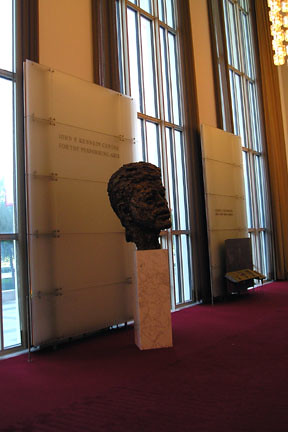
While I had my camera with me this morning at the Kennedy Center for the Festival of China, I took the opportunity to snap a few more photos inside the center and some shots of Washington and Georgetown from the Rooftop Terrace. Pictured above is the bust of John F. Kennedy in the Grand Foyer, just outside the Opera House.
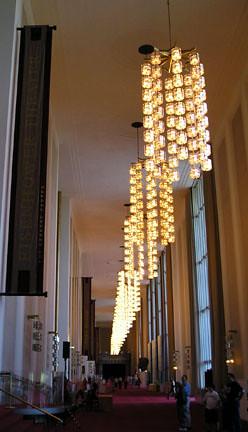
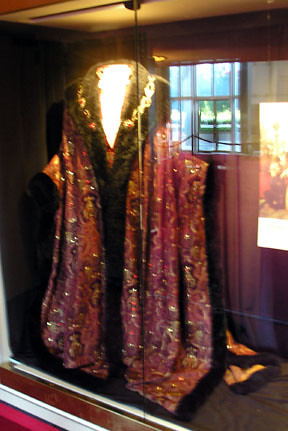
Above on the left is a view of the Grand Foyer taken from in front of the Millenium Stage, the locale where free performances are given every evening at 6 p.m. On the right is a picture of one of the costumes worn by Placido Domingo in a performance years ago at the Kennedy Center, which is enshrined in a display in the lobby of the Opera House. This particular costume is a rich, heavy brocade embroidered with gold metallic threads and studded with real gemstones. The fur trim is mink. There is quite a bit of Domingo worship around here by the local operaphiles.
On performance evenings, one can dine in one of the several Kennedy Center restaurants, including the Terrace Restaurant on the rooftop, with a view of the Lincoln Memorial. The restaurant is a little pricy, so we starving singers don't get to eat there often. Here is the October menu:
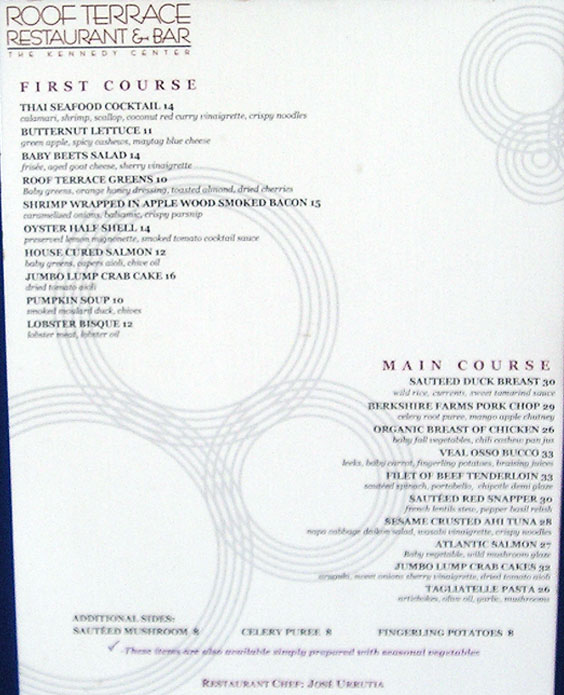
And this is a view of the Lincoln Memorial from the Rooftop Terrace:

As the Kennedy Center is set on the banks of the Potomac River, there are fine views of the river from the western side of the rooftop terrace. Here is a view of the bend in the river, from the Key Bridge on the left to the Watergate on the right, and the second picture is of rowers in front of the Georgetown waterfront. On the horizon on the far right, you can see the Washington National Cathedral.


From the north end of the terrace, one can see a great view of the infamous Watergate complex next door. One of my friends and his wife lives there, and he says it's a great big concrete monstrosity in great need of upkeep and repair, but they are limited as to what can be done due to its National Historic Register status.

Kennedy Center's Festival of China
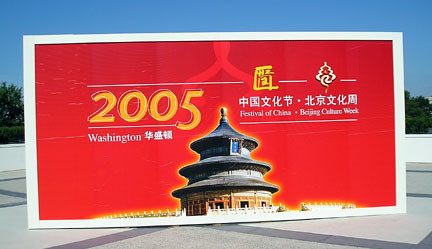
Today launched the month-long Festival of China at the Kennedy Center for the Performing Arts and I took advantage of the beautiful fall weather to wander over this morning and take a look around.
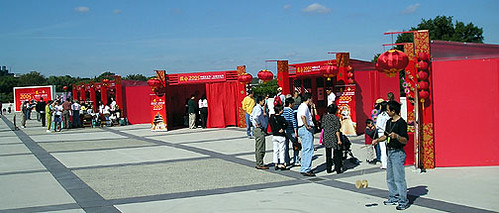
I'd actually gone to see what fun things were in the booths at the "street fair" that goes on this week only. It was a bit disappointing, since these were the only tents set up, and I'd expected a lot more, but they did have some fun works of art, calligraphy, sculpture, porcelainware, photographs, handicrafts, and various curios inside for sale. On the other side of the terrace was a "sidewalk cafe," with the table umbrellas decorated with Chinese kites. The food booths weren't open yet, but they were setting up tables with various Chinese dumplings and carts with Tsing Tao beer and Chinese plum wines.
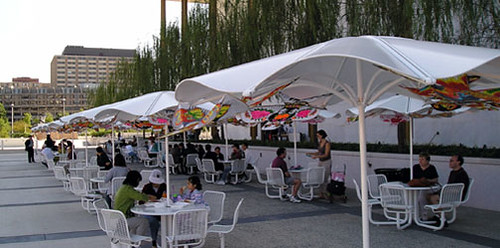
Even though events were slated to begin today at 10 a.m., they were still busy setting up a lot of stuff. Below you can see workers still installing decorations on interior windows in the Hall of Nations. In the other picture, a banner over one of the building entrances announces the Festival.
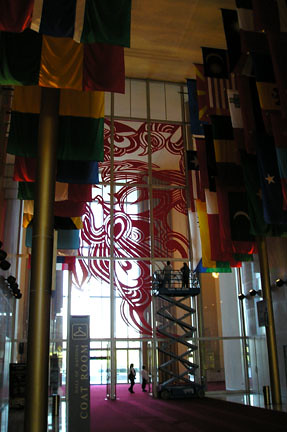
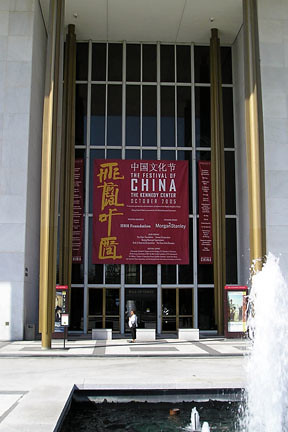
While I was wandering through the inside of the Kennedy Center looking for some of the Chinese exhibits, I caught one of the Chinese acrobat troops rehearsing in the lobby of the Eisenhower Theater. Later, I saw them outside setting up a stage on the terrace, where they were going to be giving demonstrations after lunch.
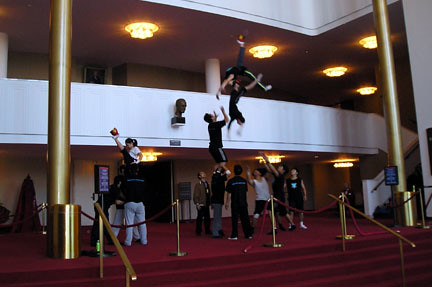
A lot of photographs of China were on display in the various halls and lobbies of the center. Upstairs, I found an exhibit dedicated to the upcoming Olympics slated to be held in Beijing. Here is a picture of one of the models of the Olympic Village. Some of the buildings look intriguing, with a natatorium that looks like it will be constructed out of glass blocks and the stadium which is a mass of graceful crystal spires.

One of the most exciting things in the festival for me is the display from the terra cotta army of Chinese Emperor Qin Shi Huang, an archeological marvel which dates back to around 210 B.C., which is something I've discussed with my humanities students in the past. Only discovered in 1974, some 8,099 terra cotta warriors and their horses were created to guard the mausoleum of the emperor, and no two warriors are alike. The Chinese government was kind enough to bring two warriors and one horse to the United States for us to view. We could not, unfortunately, touch the statutes, as they were protected behind red silk cords tied into bars and decorative knots, but we could get within about ten feet of them. When they were originally made, they were all brightly painted, and at their first rediscovery, the colors were still present, but sunlight and exposure to air after they were unearthed caused the pigments to fade, so today we just see the terra cotta, almost weathered bronze, hue.
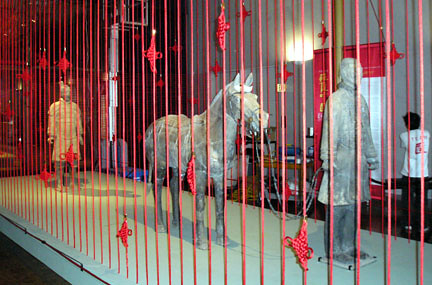
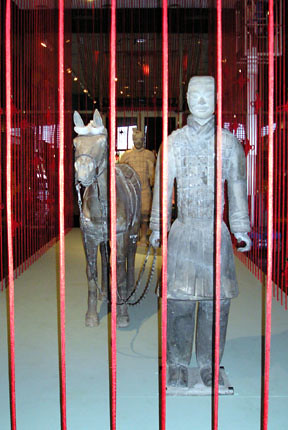
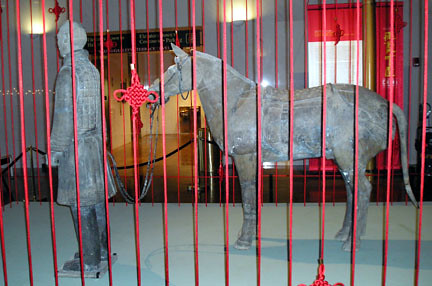
The festival continues throughout the month, and will feature all kinds of performing arts from China, including instrumental and vocal music, opera, dance, acrobatics, and the visual arts. There's a special fireworks display tonight which we may try to catch (the Watergate complex blocks our view of the Kennedy Center and the river, so we'll have to actually go over there to see it).
Thursday, September 29, 2005
Domingo conducts Verdi
International opera legend Placido Domingo took a prominent place in the orchestra pit last night as he conducted a performance of Washington National Opera's new production of Giuseppe Verdi's I Vespri Siciliani at Washington's Kennedy Center for the Performing Arts.
I had a fabulous view not only of the stage but of Maestro Domingo and his conducting—my seat was on the right side of the first row, just about even with the side line of the proscenium opening. With the orchestra below me, I was right by the tympanist, and my feet could feel his playing through the vibration of the floor. Because of the curvature of the pit and front row, I had an excellent profile view of Domingo. He loomed over the orchestra, sometimes cajoling them, sometimes singing to them, sometimes making love to them; he must be a singer's dream conductor, because he was very engaged with the stage during the difficult ensembles.
I Vespri Siciliani opens the 50th anniversary season of Washington National Opera. The season opener was a week and a half ago, but I didn't have the $650 for the ticket or the $1500 to contribute to be able to be eligible to buy a $650 ticket (plus my tuxedo is dirty). Even after the gala openings, though, WNO is very expensive—the "good" tickets at a Saturday night performance usually run about $290 (which is more than the $268 the Metropolitan Opera charges in New York City!), so I felt fortunate to have been able to score a front row ticket yesterday at a reasonable cost, especially since the house was nearly full last night.
The Washington National Opera Orchestra was in fine form last night. They play very well and very responsively for Mo. Domingo. After the overture, Domingo even took a moment to have them stand and acknowledge the audience's substantial applause.
This is the 150th anniversary of the premiere of I Vespri Siciliani, but it remains a relatively unknown opera in the United States, overshadowed by other Verdi works such as Aida, Rigoletto, La Traviata, Il Trovatore, and many others. The storyline is typically Verdian: it's a convoluted love story with a tragic ending, in five acts. Set in French-occupied Sicily in 1282, nationalistic Sicilian patriot Procida returns from exile to lead a rebellion. Procida's young lieutenant Arrigo gets himself arrested by the French governor Monforte, who shocks Arrigo when Monforte reveals that he is Arrigo's father. Torn by his long-time hatred of the French and his uncertainty over his filial duty, Arrigo saves his father from assassination. His compatriots—including Duchess Elena, his fellow rebel and the woman he loves—are arrested and condemned to death, while they condemn Arrigo as a traitor. Monforte agrees to pardon the rebels if Arrigo will acknowledge him as his father. Once Arrigo finally breaks down and acknowledges Monforte, Monforte declares that Arrigo and Elena shall be wed as a sign of the unification of the French and Sicilian peoples. Procida uses the wedding, though, as an opportunity to complete his rebellion. Now, the title of the opera translates as "Sicilian Vespers," but I really have no idea how that title ties in to the plot.
As with many Verdi operas, this opera is led by four primary singers with huge, difficult singing roles. Leading the cast as Elena is mezzo-soprano Maria Guleghina, a sturdy singer from Armenia who seemed a bit too old to me to be playing the ingenue. She had an absolutely amazing voice, though, and a great mastery of technique which a younger singer would not have had. The voice was heavy but huge; in one scene (the fourth act finale), the entire chorus, all of the principals, and the large orchestra were all singing and playing full blast, and I could hear Miss Guleghina's voice soaring above the din. I was particularly impressed with the voice of Ukrainian bass Vitalij Kowaljow, who sang the role of Procida. His soliloquy to open act two was powerful and virtuosic, earning him a prolonged ovation and plenty of bravos, including, I noticed, some applause from Maestro Domingo. Procida is a big part and it really exercises the lower range of the bass, a task which Kowaljow made simple and fluid. The baritone singing Monforte was Lado Ataneli, yet another eastern European, from Georgia. Verdi baritone parts can be misleadingly simple, sometimes soaring up into tenor registers, sometimes having a punishing tessitura, but Ataneli's interpretation just oozed with the smarmy self-confidence of a wealthy political despot. While his voice carried the timbre of a cavalier baritone, he handled his high notes easily and never appeared to be covering above the passagio. His soliloquy opening the third act also met with audience bravos. The tenor role of Arrigo was sung by Frano Farina (an American, name notwithstanding). The leading tenor role in a Verdi opera is always so demanding and so difficult, I hesitate to say that I was disappointed or unimpressed with Farina, so I will have to leave it at saying that he was not quite in the same league as the other three principals. In many of the ensembles, Farina's voice was buried under the other Russians. At one point, Farina was staged right by me and Miss Guleghina was standing on the opposite side of the stage and facing away, yet still her voice overpowered his. I wonder, also, if maybe he didn't get a little tired during the performance: his fourth act opening soliloquy was rather blasé and met only lukewarm applause from the audience.
None of the singers in the production were familiar to me, which kind of surprised me. Usually there's at least someone with whom I've previously sung. Anyway, other cast members included Erin Elizabeth Smith as Ninetta, Robert Baker as Danieli, Corey Evan Rotz as Tebaldo, James Shaffran as Roberto, John Marcus Bindel as Bethune, Benjamin von Atrops as Vaudemont (watch for this fine young bass in the future!), and J. Austin Bitner as Manfredo.
The Washington National Opera Chorus had a major presence in this production, with some 70 singers on stage, supplemented by two dozen supernumeraries. The singing was pretty good, with only one spot where the men were getting out of sequence with the stick. My complaints with the chorus, though, were with the stage director. The "acting" was that bad "opera stage business" which always looks so fake and I kept seeing recognizable personalities even though the chorus had changed costumes to portray different characters. The biggest problem, though, is that this stage director just doesn't have the gift of handling crowd scenes. The stage was too crowded and people were on top of one another. I think the actors were uncomfortable with all the steps (including some principals!), because they often looked uneasy moving around had to look down and lift their skirts and capes so as not to trip. In some of the party and dance scenes, the chorus, supernumeraries, and dancers were trying to move around and be active, but they were constrained by the vast numbers on stage, the set design, and bad direction, and they ended up looking like they were running in circles.
Oh, I almost forgot to mention that the opening of act five must have been a lady chorister's dream. As Elena prepares for her wedding to Arrigo, she and all of her "friends" (some two dozen-plus female members of the chorus) sing and dance all over the stage, each wearing a unique, gorgeous, cream colored wedding dress.
Paulo Miccichè served as both stage and visual director of the production. I think he spent too much time worrying about the "visual" direction and not enough time thinking about the stage direction. The Sicilian Mr. Miccichè is known for experimenting with moving lights and film projectors to create "virtual sets" and backdrops on stage. Well, I hope he gets over his experimental phase soon, because I hate what he's doing. It was extremely distracting and it very much detracted from the singing and the music. His vision no doubt forced set designer Antonio Mastromattei to meet Miccichè's bizarre requirements, leading to an absolutely hideous, difficult, and undesirable set. And I have no idea when this opera was supposed to be set. Verdi and his librettist set the work in the 13th century. The costumes all appeared to be 19th century. The sets appeared to be almost futuristic.
So, let's talk about the set. A series of five stark, "stone" black, contemporary, rectangular arches framed the stage from front to back. Runs of three to four steps in black, stage-wide staircases, beginning with three steps below the first arch, continued all the way upstage, with a few landings to allow for some action, and a more substantial landing about mid-stage where two large movable black staircases could be moved from place to place. A large black scrim (scrims are those special flat curtains which can either be opaque or see-through, depending upon the lighting) was hanging in the first arch. During the overture, the stage lights came up a bit, revealing through the scrim three enormous empty picture frames floating over the set: a horizontal frame centered up stage, a vertical frame down right, and a vertical frame set on the diagonal mid-stage left. During the course the evening, the frames would appear and reappear. The horizontal frame was on ropes, so it could go up and down. The two vertical frames were on rollers, but rather than being mechanically controlled, they were pushed on and off by stage hands in "costume" shirts, but with their blue jeans and work boots visible underneath. As the overture came to a conclusion, a stage-wide, transparent portrait of Verdi was rolled up and projected on to the front scrim.
Once the singing started, old-style photographs of Sicily were projected on to the backdrop up stage. As the action shifted, the photographs moved laterally to reveal different sections of the panorama. It made me seasick. Later, when the director was wanting to reflect the emotion being sung by a soloist or small ensemble, he would project photographs of old medieval and Renaissance era Sicilian paintings or sculptures. During a love duet between Elena and Arrigo, the painting was of two medieval lovers locked in a deep kiss. When Monforte gave Arrigo a letter from his mother explaining that Monforte was Arrigo's father, "handwriting" was projected over the entire stage. Sometimes sections of paintings would be highlighted and projected on shades which rolled down from the tops of the frames, while the full painting was projected in back. In several sections of the show, a white scrim with multiple vertical cuts along the bottom (to allow for the occasional "dramatic" entrance) was lowered about mid stage and used as both scrim and projection screen.
I found all the "high tech" and projections to be highly distracting, and I would discard Miccichè's concept. I think Verdi is a good enough composer to be able to convey his message and the emotion of the characters without needing projected visual clues to tell the audience what to think or feel. Yes, the opera was sung in its original Italian, but the English translations were projected on to the top of the downstage proscenium arch (and I seldom looked at them). Sometimes the high tech malfunctioned, though, and that was disasterous: in one particularly poignant fourth act quartet, the projector shining a painting over the entire stage was shaking, and I could not look at the stage without experiencing vertigo.
Some of the basic technical aspects of the staging were also disappointing, given the stature and expense of Washington National Opera. Now, we know that it is common practice to use a scrim to hide scene changes while other singing is going on down stage. People and props have to get on and off stage. And, of course, you can't expect an opera singer to walk on and off a stage set (especially one with a lot of stairs) when it is pitch black. For those of you unfamiliar with stagecraft and the operation of a scrim, a scrim is opaque to the audience when there is a light shining on it from the front and the set is dark in back—you make whatever is behind it visible by illuminating the scene back there. So, we certainly know that if stage lights are raised enough to allow actors to get on and off the set, the audience is going to be able to see a hazy vision of what's going on. The simple solution to that is to use what we call a "black out curtain"—typically a rubberized sheet—in conjunction with the scrim that is flown back out as soon as the scene is set and the lights lowered again. Well, they didn't use black out curtains last night, so many of the scene changes were faintly visible and that distracted us from the singing in front. And, at the end of several acts, the lights came down and curtains began to come in from the top, only to have to stop midway down to allow the actors to clear the stage before they could finish closing. Now, how unprofessional does that look?
So, I think I can sum up the performance by saying the music was divine and the staging and sets sucked.
A great deal of the opera experience, though, doesn't happen inside the auditorium. I love to people watch! And the Kennedy Center is a perfect place for that, because not only do they have an opera house, they have a concert hall, a big stage theater, and several smaller theaters, plus a couple of gourmet restaurants and a big gift shop. During major concerts and performances, additional tables are set up to sell refreshments and drinks, including a new martini bar I discovered last night. The lobbies are so huge they are often used for receptions and other gatherings, and last night was no exception.
I'm not sure exactly who was doing what, but the press was teeming all over the place, because actress Angelina Jolie supposedly was coming for some event. There were crowds behind ropes outside the doors waiting for a glimpse of Miss Jolie, just like at the Academy Awards. I'm not sure if I was supposed to have gone that way, but I walked on the red carpet, straight up the stairs, past the crowds, and into the Hall of Nations. As I went up the stairs, I heard someone behind the ropes calling "Mark! Mark!" and turned to see one of my condo employees, who wanted to know if I was there for "the Event." Joan Rivers wasn't there to stop and interview me, but had she asked, I was wearing Armani: I'd chosen a navy pinstriped suit and white broadcloth French-cuffed shirt by Brooks Brothers with a light grey tie spotted with blue mitochondria-like figures by Giorgio Armani.
Fashions were very mixed last night. Of course, it wasn't opening night, so the formality wasn't there and it was a typical night out in Washington. As is so unfortunately typical these days, one sees a broad variety of clothing at these public events. I only saw two men in tuxedoes, but their accompanying women were quite unfortunately attired in outfits which were not only way too casual for black tie but hideous in and of themselves. Most of the men seemed to be in dark blue or grey suits, a pleasant thing since I've been to the opera in places like St. Louis where most of the men were in tacky brown suits or blue blazer and khaki trouser combinations (if they were even wearing a tie). Suits are still standard two piece numbers with no vests, and most of the men are avoiding that currently vogue three-buttons buttoned up look on ventless suit jackets. I also saw probably a majority of the men in blue shirts, though I'm not seeing as many French cuffs as I was earlier in the year.
Women's fashions were far, far more varied. I really only noticed a few trends. First, I saw a lot of knee-length black dresses and black suits topped with very colorful shawls and oversized scarves in both solid and multicolor blues, greens, and fuschias. Soft, smooth, thin woolens with elegant tailored lines also seem to be in, and I noticed a lot of dresses and skirt-top combinations with jackets, all in the same fabric. Some of these suits were black, but I also saw a lot of grey, beige, and soft pink. Chiffon-type fabrics also seemed popular for dresses with full skirts and high heeled shoes dyed to match. The vast majority of the women were in knee-length dresses, with the younger women wearing mid-knee hemlines and the more mature women's hems resting just below the knee. No one seemed to be wearing sequins, beaded fabrics, or shiny things (though it is still a bit early in the season for that). Hair is a little longer and smoothly coiffed. Jewelry was restrained, and simple pearl stands seemed popular again. Brooches were popular on suit jackets (hints of Madeleine Albright). There were a few ladies in long skirts (not dresses), but I didn't find them looking particularly formal or elegant. Most were ankle length and very, very colorful with boring tops. Those ladies particularly seemed to have difficulty selecting stylish and appropriate footware to go with their long skirts. I also saw a few older women in evening pants, typically with very colorful tops with long, draping sleeves and back. There weren't many young women in the audience at all. The few I saw obviously have not yet acquired a sense of taste or style, and neither had their boyfriends. I also saw some younger stag females wandering around in ill-fitting pant suits, and all I can say is fat and sloppy isn't going to land you a husband, sweetie. I sat next to an English lady now living in Canada who had a short, coiffed hairdo and wore simple diamond clip-on earrings to offset her cocktail length, pink chiffon dress, matching pink light woolen cape trimmed in pink fur, and dyed-to-match shoes with grosgrain bows. She was very interesting, and seems to be quite a Domingo fan. She's also gone to every performance of I Vespri Siciliani, and says she plans to see the remaining four performances.
I don't know about seeing all four of the remaining shows, but if you get a chances, this is a great opportunity to see a dramatic and rarely performed opera, and the soprano and bass alone make the ticket price worth the expense. Steel yourself for a long evening, though—running time, including two intermissions, was three hours and 45 minutes!
I had a fabulous view not only of the stage but of Maestro Domingo and his conducting—my seat was on the right side of the first row, just about even with the side line of the proscenium opening. With the orchestra below me, I was right by the tympanist, and my feet could feel his playing through the vibration of the floor. Because of the curvature of the pit and front row, I had an excellent profile view of Domingo. He loomed over the orchestra, sometimes cajoling them, sometimes singing to them, sometimes making love to them; he must be a singer's dream conductor, because he was very engaged with the stage during the difficult ensembles.
I Vespri Siciliani opens the 50th anniversary season of Washington National Opera. The season opener was a week and a half ago, but I didn't have the $650 for the ticket or the $1500 to contribute to be able to be eligible to buy a $650 ticket (plus my tuxedo is dirty). Even after the gala openings, though, WNO is very expensive—the "good" tickets at a Saturday night performance usually run about $290 (which is more than the $268 the Metropolitan Opera charges in New York City!), so I felt fortunate to have been able to score a front row ticket yesterday at a reasonable cost, especially since the house was nearly full last night.
The Washington National Opera Orchestra was in fine form last night. They play very well and very responsively for Mo. Domingo. After the overture, Domingo even took a moment to have them stand and acknowledge the audience's substantial applause.
This is the 150th anniversary of the premiere of I Vespri Siciliani, but it remains a relatively unknown opera in the United States, overshadowed by other Verdi works such as Aida, Rigoletto, La Traviata, Il Trovatore, and many others. The storyline is typically Verdian: it's a convoluted love story with a tragic ending, in five acts. Set in French-occupied Sicily in 1282, nationalistic Sicilian patriot Procida returns from exile to lead a rebellion. Procida's young lieutenant Arrigo gets himself arrested by the French governor Monforte, who shocks Arrigo when Monforte reveals that he is Arrigo's father. Torn by his long-time hatred of the French and his uncertainty over his filial duty, Arrigo saves his father from assassination. His compatriots—including Duchess Elena, his fellow rebel and the woman he loves—are arrested and condemned to death, while they condemn Arrigo as a traitor. Monforte agrees to pardon the rebels if Arrigo will acknowledge him as his father. Once Arrigo finally breaks down and acknowledges Monforte, Monforte declares that Arrigo and Elena shall be wed as a sign of the unification of the French and Sicilian peoples. Procida uses the wedding, though, as an opportunity to complete his rebellion. Now, the title of the opera translates as "Sicilian Vespers," but I really have no idea how that title ties in to the plot.
As with many Verdi operas, this opera is led by four primary singers with huge, difficult singing roles. Leading the cast as Elena is mezzo-soprano Maria Guleghina, a sturdy singer from Armenia who seemed a bit too old to me to be playing the ingenue. She had an absolutely amazing voice, though, and a great mastery of technique which a younger singer would not have had. The voice was heavy but huge; in one scene (the fourth act finale), the entire chorus, all of the principals, and the large orchestra were all singing and playing full blast, and I could hear Miss Guleghina's voice soaring above the din. I was particularly impressed with the voice of Ukrainian bass Vitalij Kowaljow, who sang the role of Procida. His soliloquy to open act two was powerful and virtuosic, earning him a prolonged ovation and plenty of bravos, including, I noticed, some applause from Maestro Domingo. Procida is a big part and it really exercises the lower range of the bass, a task which Kowaljow made simple and fluid. The baritone singing Monforte was Lado Ataneli, yet another eastern European, from Georgia. Verdi baritone parts can be misleadingly simple, sometimes soaring up into tenor registers, sometimes having a punishing tessitura, but Ataneli's interpretation just oozed with the smarmy self-confidence of a wealthy political despot. While his voice carried the timbre of a cavalier baritone, he handled his high notes easily and never appeared to be covering above the passagio. His soliloquy opening the third act also met with audience bravos. The tenor role of Arrigo was sung by Frano Farina (an American, name notwithstanding). The leading tenor role in a Verdi opera is always so demanding and so difficult, I hesitate to say that I was disappointed or unimpressed with Farina, so I will have to leave it at saying that he was not quite in the same league as the other three principals. In many of the ensembles, Farina's voice was buried under the other Russians. At one point, Farina was staged right by me and Miss Guleghina was standing on the opposite side of the stage and facing away, yet still her voice overpowered his. I wonder, also, if maybe he didn't get a little tired during the performance: his fourth act opening soliloquy was rather blasé and met only lukewarm applause from the audience.
None of the singers in the production were familiar to me, which kind of surprised me. Usually there's at least someone with whom I've previously sung. Anyway, other cast members included Erin Elizabeth Smith as Ninetta, Robert Baker as Danieli, Corey Evan Rotz as Tebaldo, James Shaffran as Roberto, John Marcus Bindel as Bethune, Benjamin von Atrops as Vaudemont (watch for this fine young bass in the future!), and J. Austin Bitner as Manfredo.
The Washington National Opera Chorus had a major presence in this production, with some 70 singers on stage, supplemented by two dozen supernumeraries. The singing was pretty good, with only one spot where the men were getting out of sequence with the stick. My complaints with the chorus, though, were with the stage director. The "acting" was that bad "opera stage business" which always looks so fake and I kept seeing recognizable personalities even though the chorus had changed costumes to portray different characters. The biggest problem, though, is that this stage director just doesn't have the gift of handling crowd scenes. The stage was too crowded and people were on top of one another. I think the actors were uncomfortable with all the steps (including some principals!), because they often looked uneasy moving around had to look down and lift their skirts and capes so as not to trip. In some of the party and dance scenes, the chorus, supernumeraries, and dancers were trying to move around and be active, but they were constrained by the vast numbers on stage, the set design, and bad direction, and they ended up looking like they were running in circles.
Oh, I almost forgot to mention that the opening of act five must have been a lady chorister's dream. As Elena prepares for her wedding to Arrigo, she and all of her "friends" (some two dozen-plus female members of the chorus) sing and dance all over the stage, each wearing a unique, gorgeous, cream colored wedding dress.
Paulo Miccichè served as both stage and visual director of the production. I think he spent too much time worrying about the "visual" direction and not enough time thinking about the stage direction. The Sicilian Mr. Miccichè is known for experimenting with moving lights and film projectors to create "virtual sets" and backdrops on stage. Well, I hope he gets over his experimental phase soon, because I hate what he's doing. It was extremely distracting and it very much detracted from the singing and the music. His vision no doubt forced set designer Antonio Mastromattei to meet Miccichè's bizarre requirements, leading to an absolutely hideous, difficult, and undesirable set. And I have no idea when this opera was supposed to be set. Verdi and his librettist set the work in the 13th century. The costumes all appeared to be 19th century. The sets appeared to be almost futuristic.
So, let's talk about the set. A series of five stark, "stone" black, contemporary, rectangular arches framed the stage from front to back. Runs of three to four steps in black, stage-wide staircases, beginning with three steps below the first arch, continued all the way upstage, with a few landings to allow for some action, and a more substantial landing about mid-stage where two large movable black staircases could be moved from place to place. A large black scrim (scrims are those special flat curtains which can either be opaque or see-through, depending upon the lighting) was hanging in the first arch. During the overture, the stage lights came up a bit, revealing through the scrim three enormous empty picture frames floating over the set: a horizontal frame centered up stage, a vertical frame down right, and a vertical frame set on the diagonal mid-stage left. During the course the evening, the frames would appear and reappear. The horizontal frame was on ropes, so it could go up and down. The two vertical frames were on rollers, but rather than being mechanically controlled, they were pushed on and off by stage hands in "costume" shirts, but with their blue jeans and work boots visible underneath. As the overture came to a conclusion, a stage-wide, transparent portrait of Verdi was rolled up and projected on to the front scrim.
Once the singing started, old-style photographs of Sicily were projected on to the backdrop up stage. As the action shifted, the photographs moved laterally to reveal different sections of the panorama. It made me seasick. Later, when the director was wanting to reflect the emotion being sung by a soloist or small ensemble, he would project photographs of old medieval and Renaissance era Sicilian paintings or sculptures. During a love duet between Elena and Arrigo, the painting was of two medieval lovers locked in a deep kiss. When Monforte gave Arrigo a letter from his mother explaining that Monforte was Arrigo's father, "handwriting" was projected over the entire stage. Sometimes sections of paintings would be highlighted and projected on shades which rolled down from the tops of the frames, while the full painting was projected in back. In several sections of the show, a white scrim with multiple vertical cuts along the bottom (to allow for the occasional "dramatic" entrance) was lowered about mid stage and used as both scrim and projection screen.
I found all the "high tech" and projections to be highly distracting, and I would discard Miccichè's concept. I think Verdi is a good enough composer to be able to convey his message and the emotion of the characters without needing projected visual clues to tell the audience what to think or feel. Yes, the opera was sung in its original Italian, but the English translations were projected on to the top of the downstage proscenium arch (and I seldom looked at them). Sometimes the high tech malfunctioned, though, and that was disasterous: in one particularly poignant fourth act quartet, the projector shining a painting over the entire stage was shaking, and I could not look at the stage without experiencing vertigo.
Some of the basic technical aspects of the staging were also disappointing, given the stature and expense of Washington National Opera. Now, we know that it is common practice to use a scrim to hide scene changes while other singing is going on down stage. People and props have to get on and off stage. And, of course, you can't expect an opera singer to walk on and off a stage set (especially one with a lot of stairs) when it is pitch black. For those of you unfamiliar with stagecraft and the operation of a scrim, a scrim is opaque to the audience when there is a light shining on it from the front and the set is dark in back—you make whatever is behind it visible by illuminating the scene back there. So, we certainly know that if stage lights are raised enough to allow actors to get on and off the set, the audience is going to be able to see a hazy vision of what's going on. The simple solution to that is to use what we call a "black out curtain"—typically a rubberized sheet—in conjunction with the scrim that is flown back out as soon as the scene is set and the lights lowered again. Well, they didn't use black out curtains last night, so many of the scene changes were faintly visible and that distracted us from the singing in front. And, at the end of several acts, the lights came down and curtains began to come in from the top, only to have to stop midway down to allow the actors to clear the stage before they could finish closing. Now, how unprofessional does that look?
So, I think I can sum up the performance by saying the music was divine and the staging and sets sucked.
A great deal of the opera experience, though, doesn't happen inside the auditorium. I love to people watch! And the Kennedy Center is a perfect place for that, because not only do they have an opera house, they have a concert hall, a big stage theater, and several smaller theaters, plus a couple of gourmet restaurants and a big gift shop. During major concerts and performances, additional tables are set up to sell refreshments and drinks, including a new martini bar I discovered last night. The lobbies are so huge they are often used for receptions and other gatherings, and last night was no exception.
I'm not sure exactly who was doing what, but the press was teeming all over the place, because actress Angelina Jolie supposedly was coming for some event. There were crowds behind ropes outside the doors waiting for a glimpse of Miss Jolie, just like at the Academy Awards. I'm not sure if I was supposed to have gone that way, but I walked on the red carpet, straight up the stairs, past the crowds, and into the Hall of Nations. As I went up the stairs, I heard someone behind the ropes calling "Mark! Mark!" and turned to see one of my condo employees, who wanted to know if I was there for "the Event." Joan Rivers wasn't there to stop and interview me, but had she asked, I was wearing Armani: I'd chosen a navy pinstriped suit and white broadcloth French-cuffed shirt by Brooks Brothers with a light grey tie spotted with blue mitochondria-like figures by Giorgio Armani.
Fashions were very mixed last night. Of course, it wasn't opening night, so the formality wasn't there and it was a typical night out in Washington. As is so unfortunately typical these days, one sees a broad variety of clothing at these public events. I only saw two men in tuxedoes, but their accompanying women were quite unfortunately attired in outfits which were not only way too casual for black tie but hideous in and of themselves. Most of the men seemed to be in dark blue or grey suits, a pleasant thing since I've been to the opera in places like St. Louis where most of the men were in tacky brown suits or blue blazer and khaki trouser combinations (if they were even wearing a tie). Suits are still standard two piece numbers with no vests, and most of the men are avoiding that currently vogue three-buttons buttoned up look on ventless suit jackets. I also saw probably a majority of the men in blue shirts, though I'm not seeing as many French cuffs as I was earlier in the year.
Women's fashions were far, far more varied. I really only noticed a few trends. First, I saw a lot of knee-length black dresses and black suits topped with very colorful shawls and oversized scarves in both solid and multicolor blues, greens, and fuschias. Soft, smooth, thin woolens with elegant tailored lines also seem to be in, and I noticed a lot of dresses and skirt-top combinations with jackets, all in the same fabric. Some of these suits were black, but I also saw a lot of grey, beige, and soft pink. Chiffon-type fabrics also seemed popular for dresses with full skirts and high heeled shoes dyed to match. The vast majority of the women were in knee-length dresses, with the younger women wearing mid-knee hemlines and the more mature women's hems resting just below the knee. No one seemed to be wearing sequins, beaded fabrics, or shiny things (though it is still a bit early in the season for that). Hair is a little longer and smoothly coiffed. Jewelry was restrained, and simple pearl stands seemed popular again. Brooches were popular on suit jackets (hints of Madeleine Albright). There were a few ladies in long skirts (not dresses), but I didn't find them looking particularly formal or elegant. Most were ankle length and very, very colorful with boring tops. Those ladies particularly seemed to have difficulty selecting stylish and appropriate footware to go with their long skirts. I also saw a few older women in evening pants, typically with very colorful tops with long, draping sleeves and back. There weren't many young women in the audience at all. The few I saw obviously have not yet acquired a sense of taste or style, and neither had their boyfriends. I also saw some younger stag females wandering around in ill-fitting pant suits, and all I can say is fat and sloppy isn't going to land you a husband, sweetie. I sat next to an English lady now living in Canada who had a short, coiffed hairdo and wore simple diamond clip-on earrings to offset her cocktail length, pink chiffon dress, matching pink light woolen cape trimmed in pink fur, and dyed-to-match shoes with grosgrain bows. She was very interesting, and seems to be quite a Domingo fan. She's also gone to every performance of I Vespri Siciliani, and says she plans to see the remaining four performances.
I don't know about seeing all four of the remaining shows, but if you get a chances, this is a great opportunity to see a dramatic and rarely performed opera, and the soprano and bass alone make the ticket price worth the expense. Steel yourself for a long evening, though—running time, including two intermissions, was three hours and 45 minutes!
Subscribe to:
Posts (Atom)
